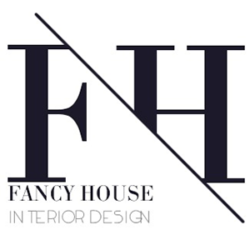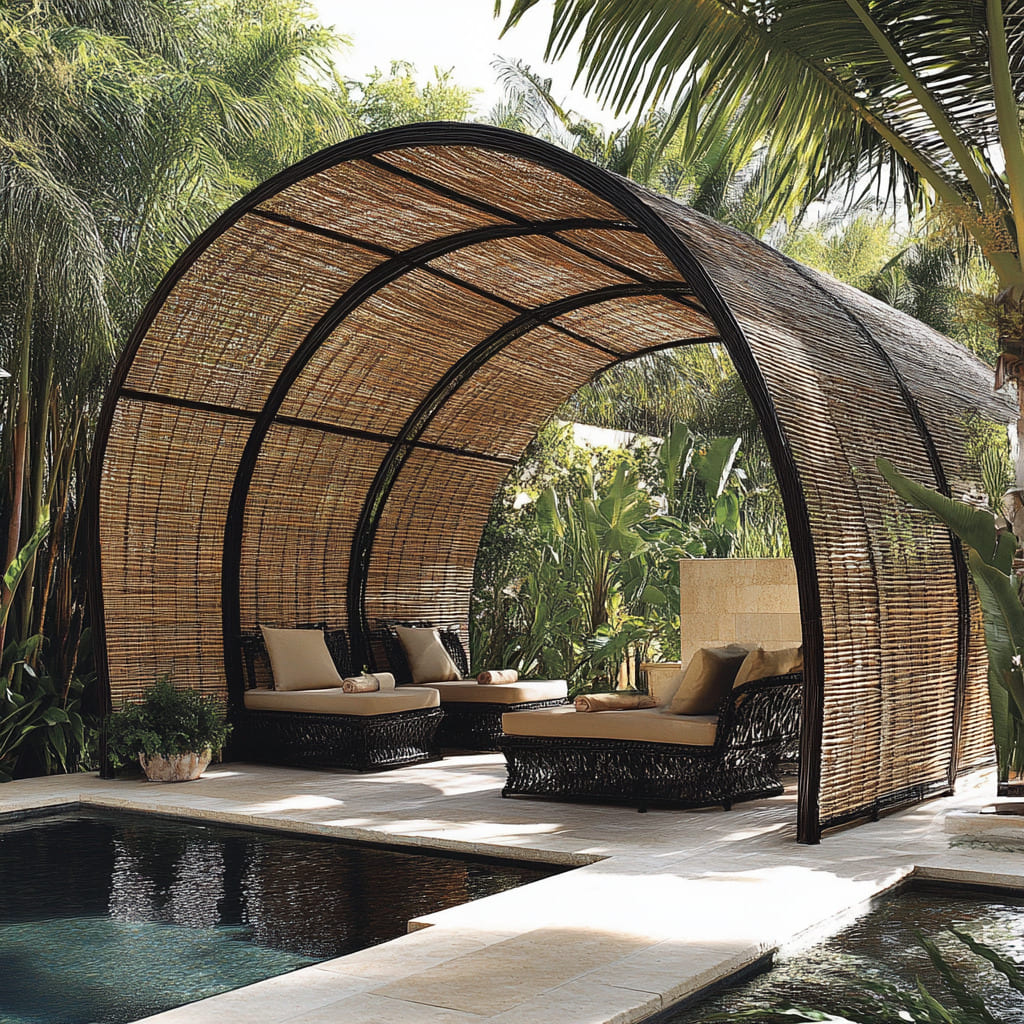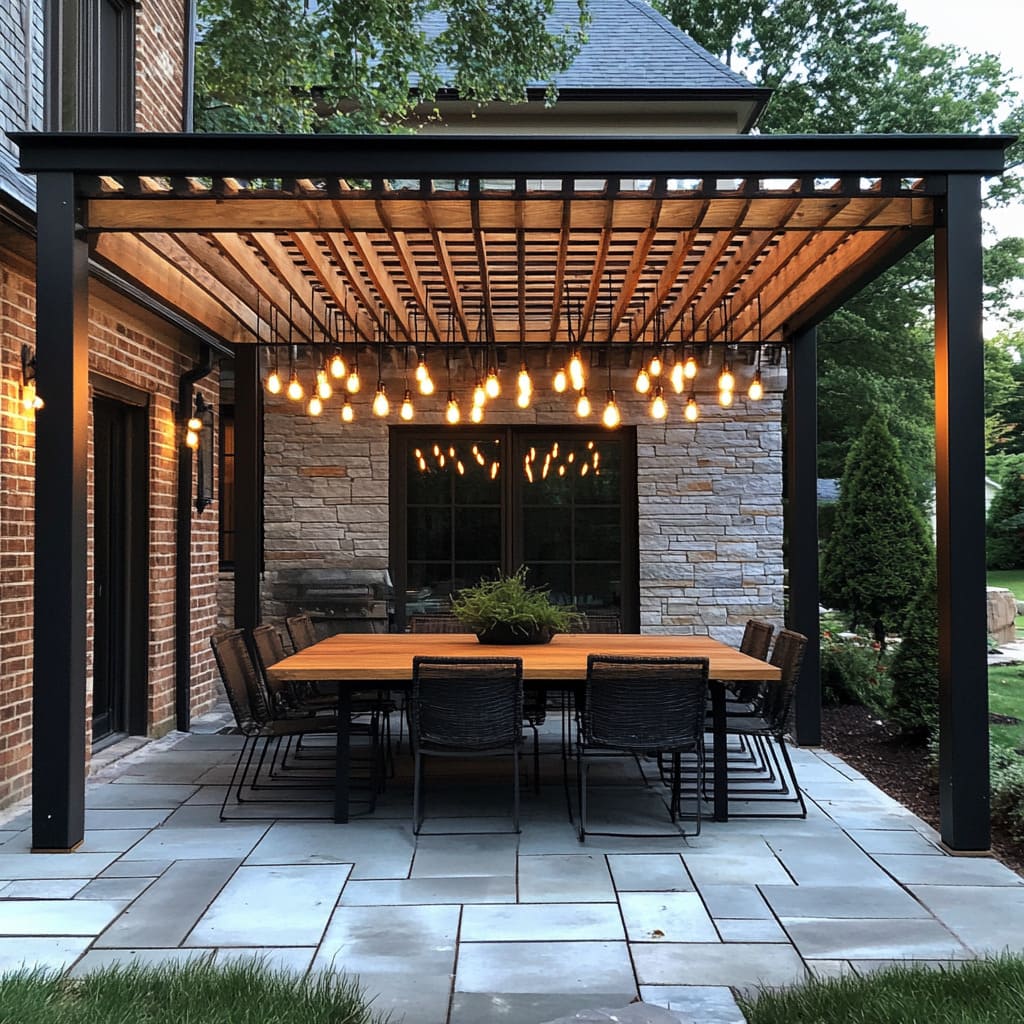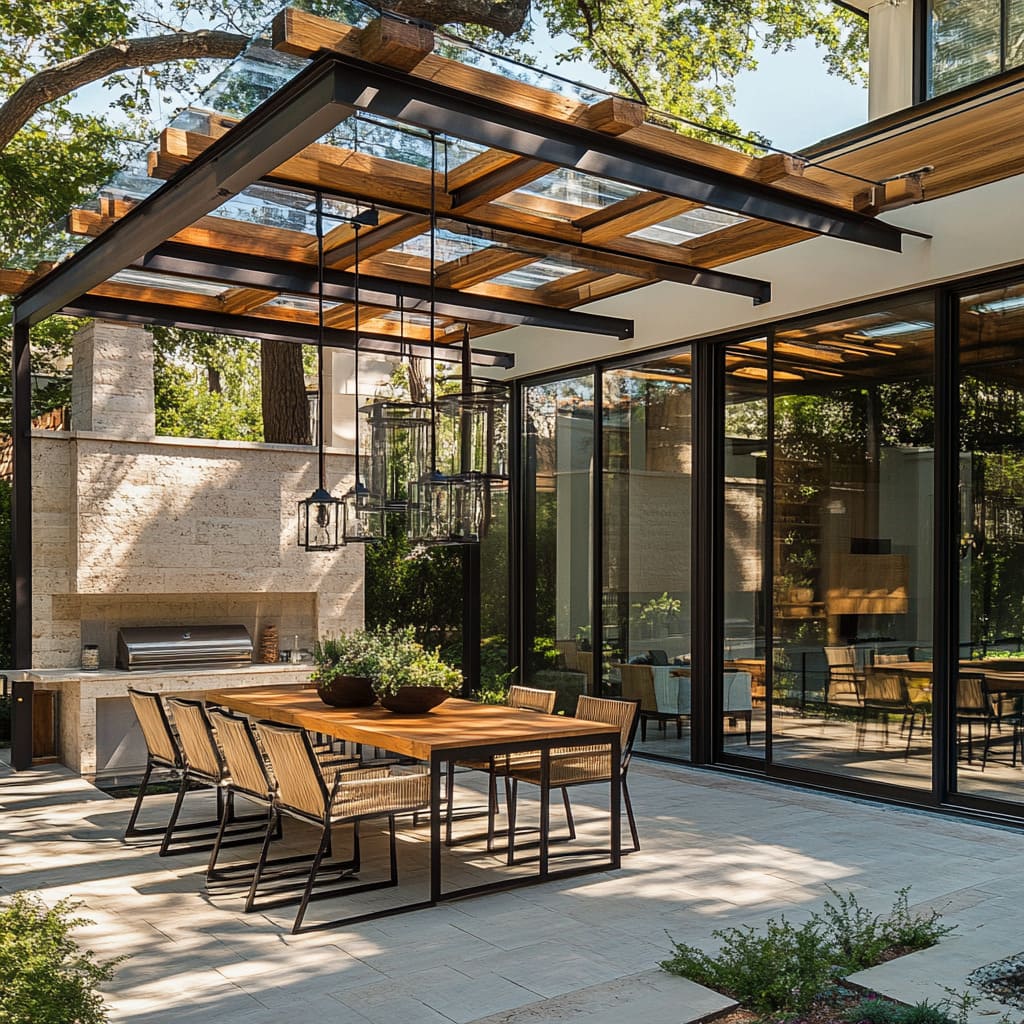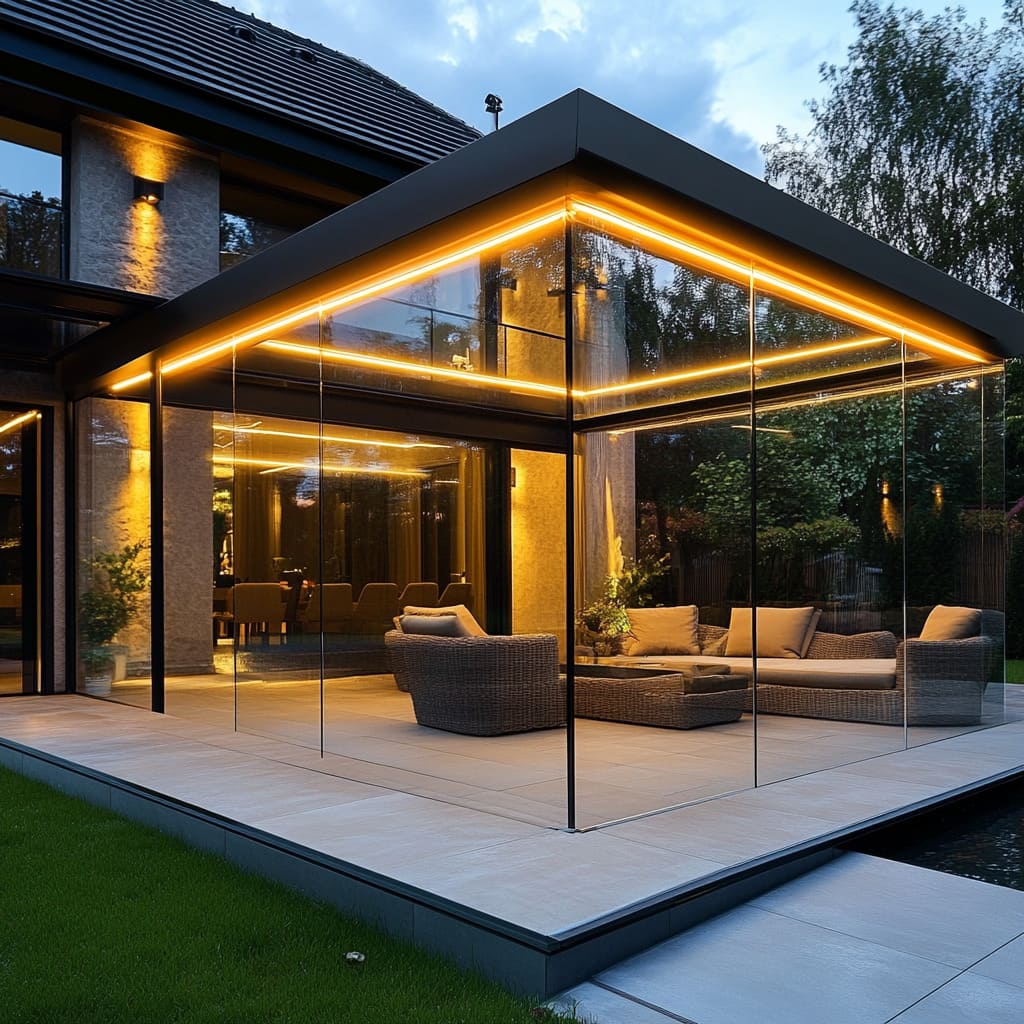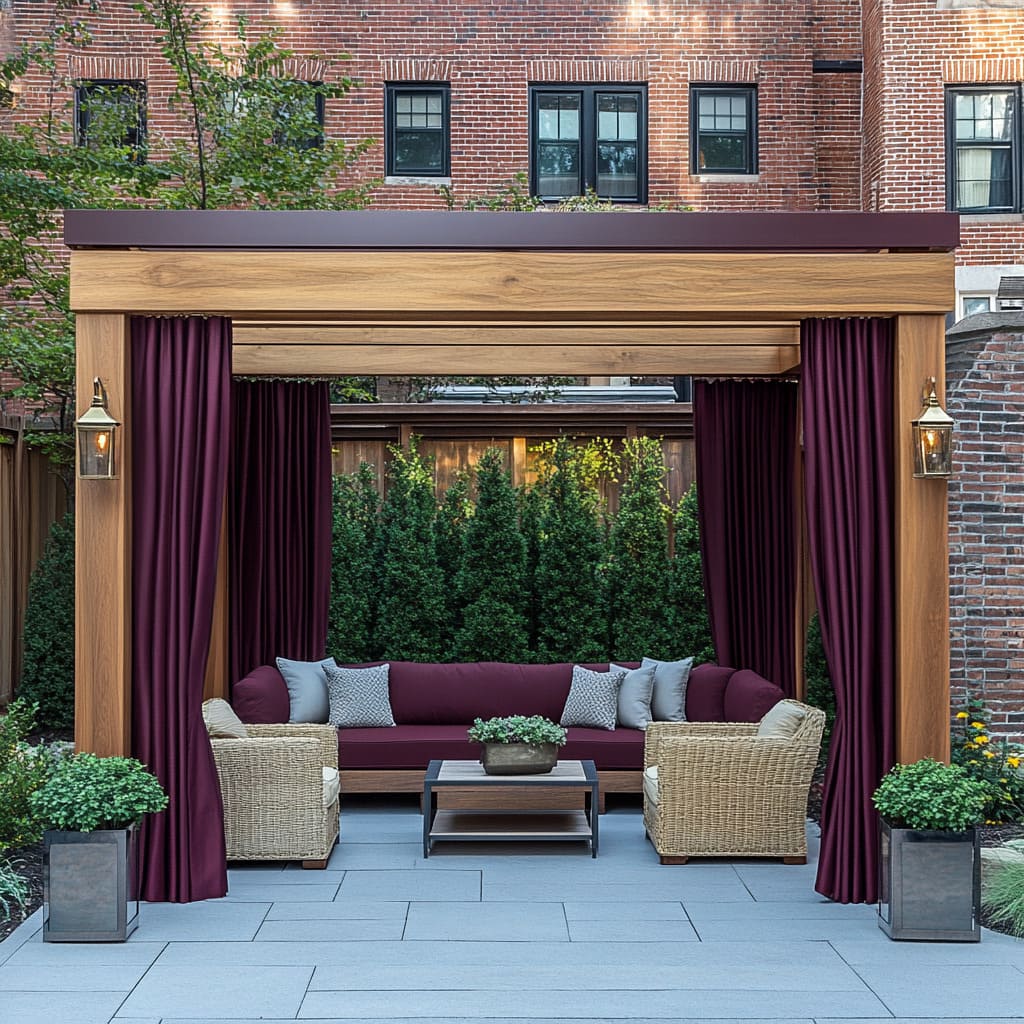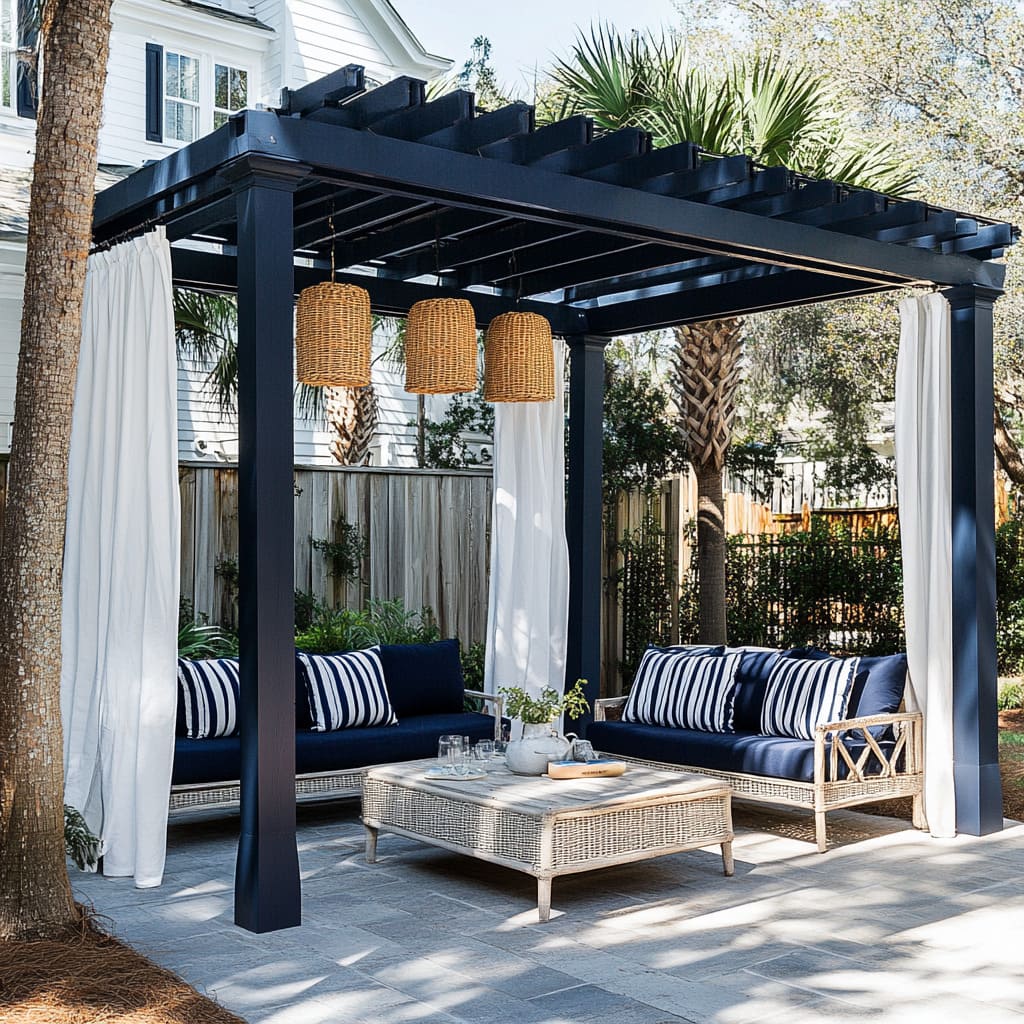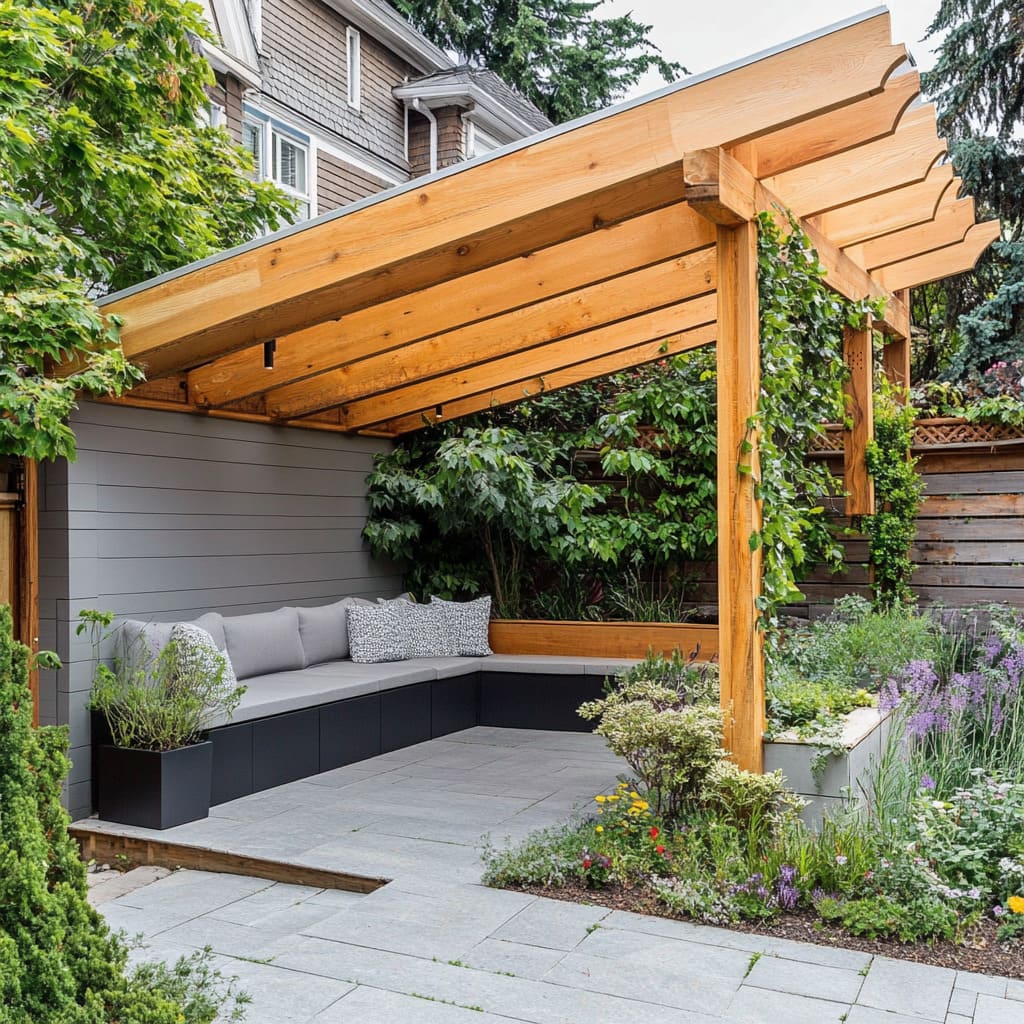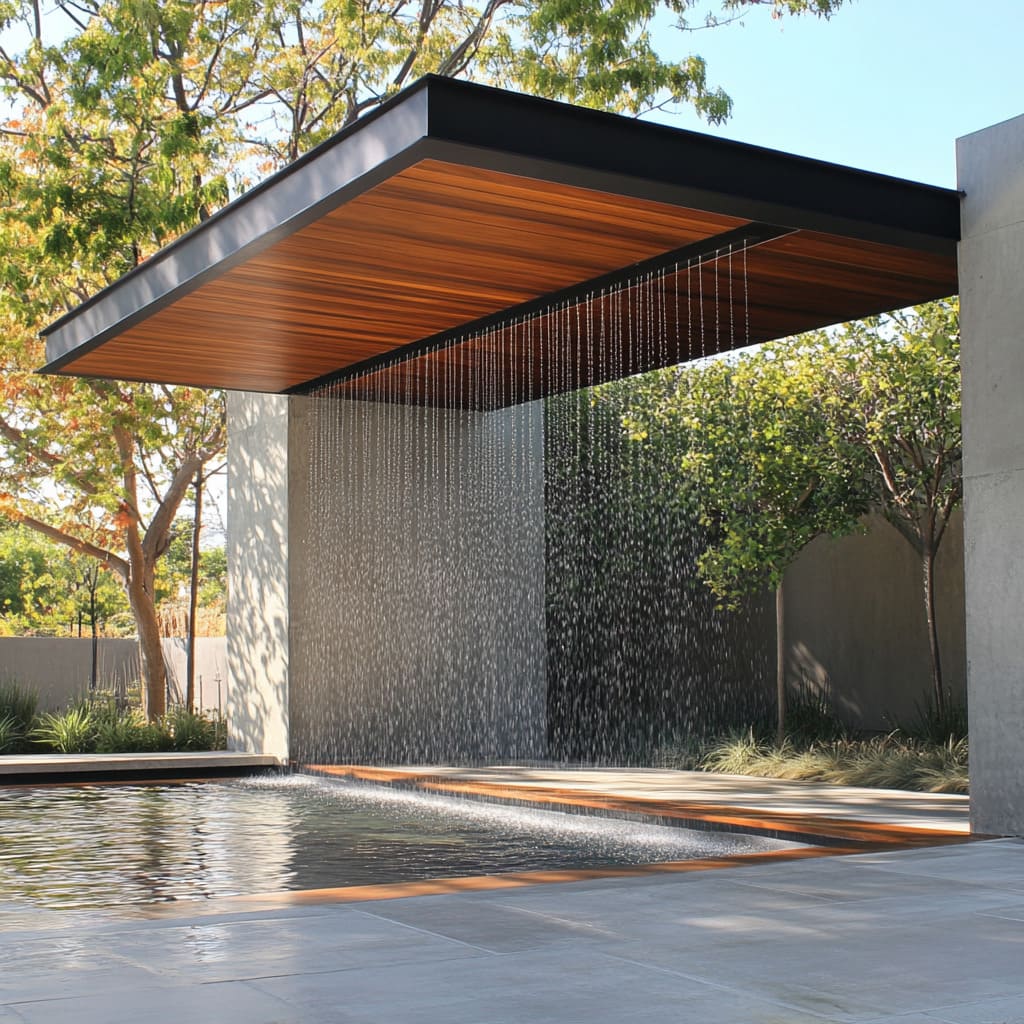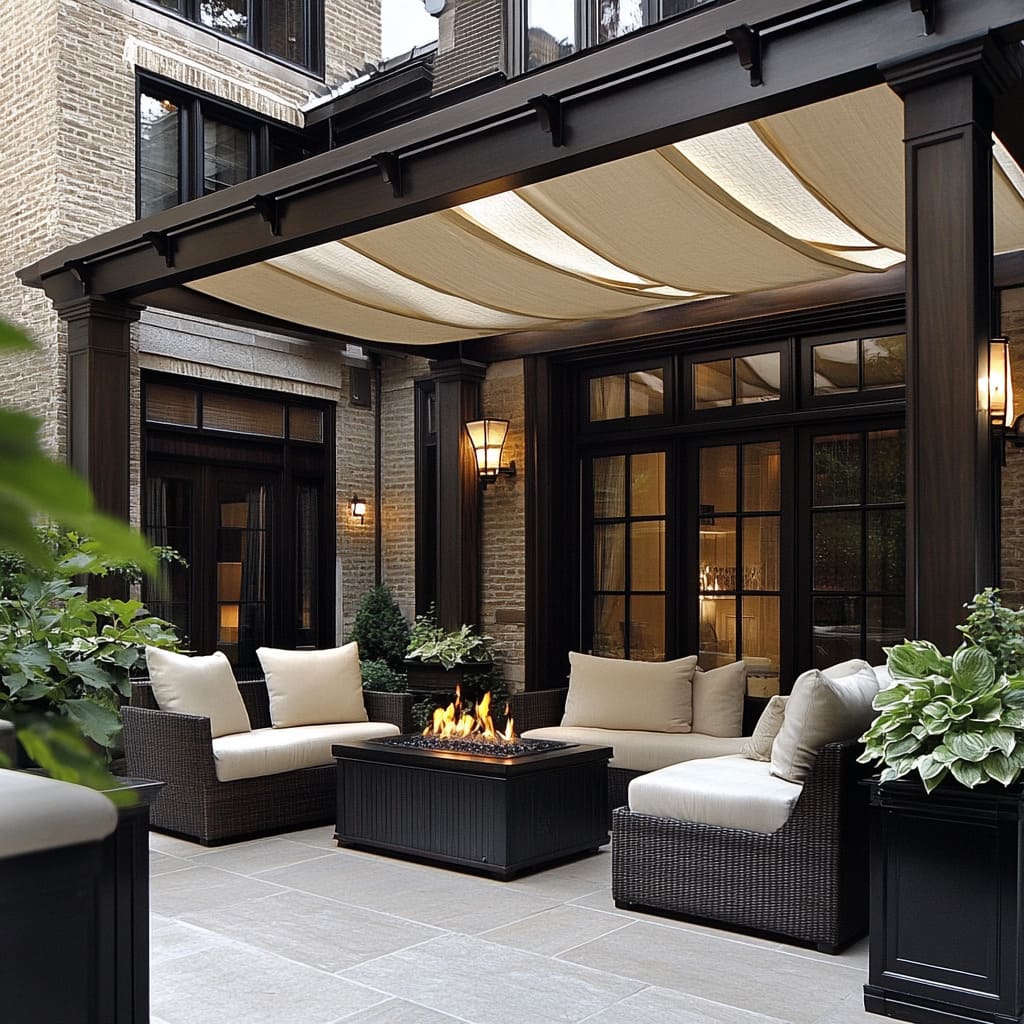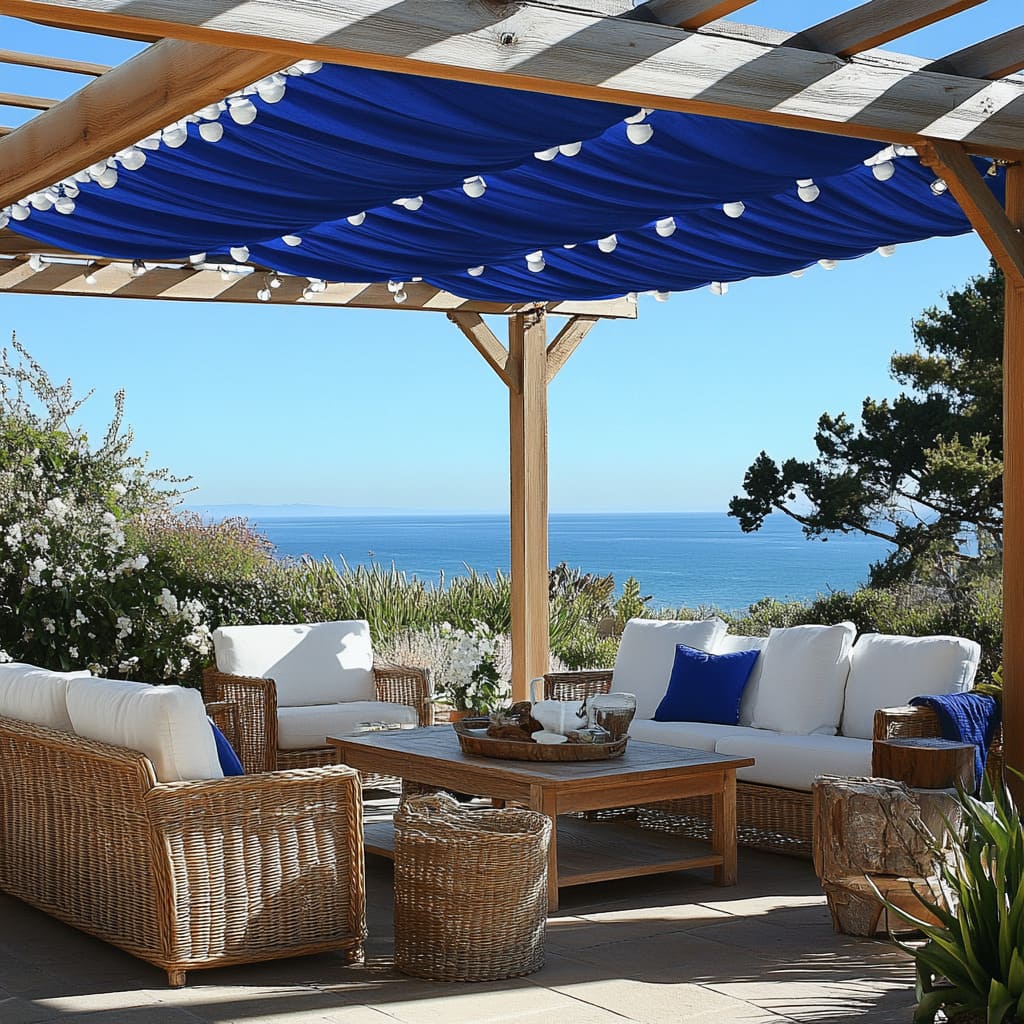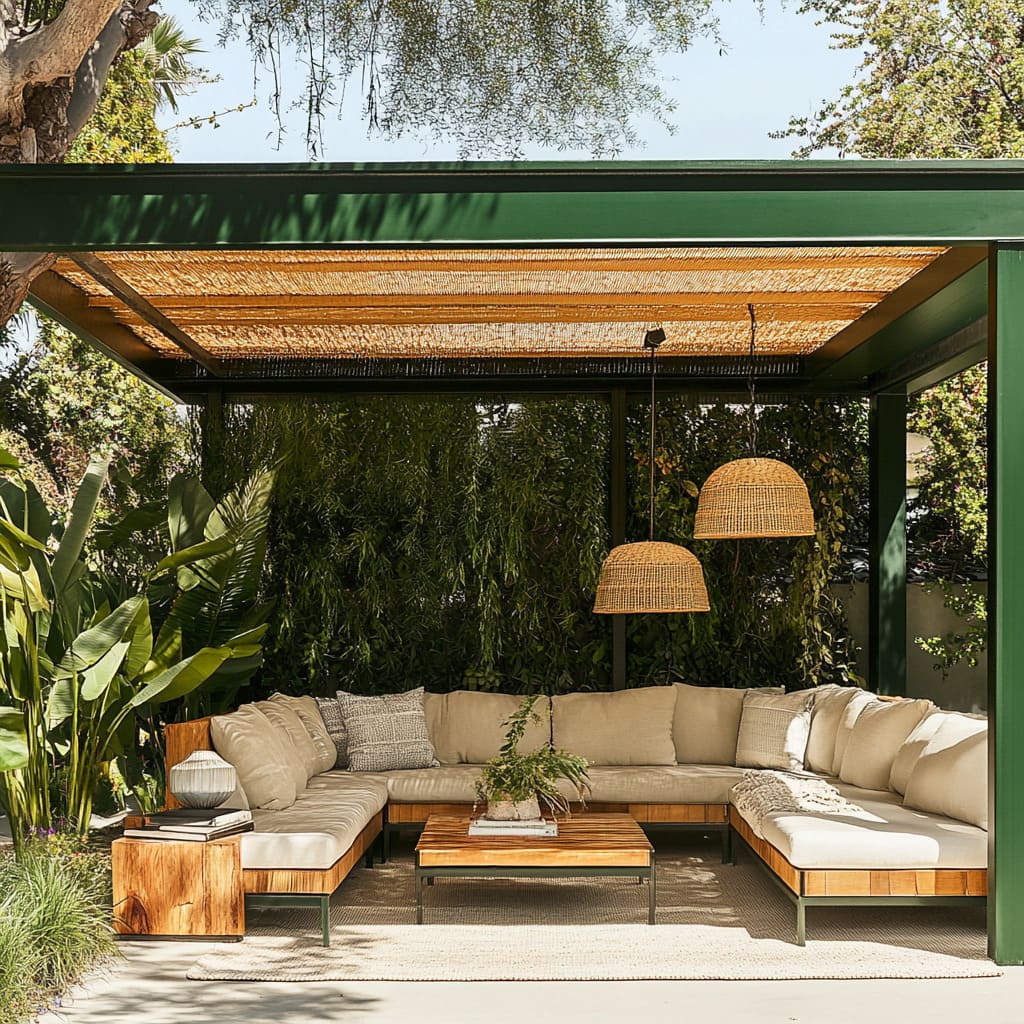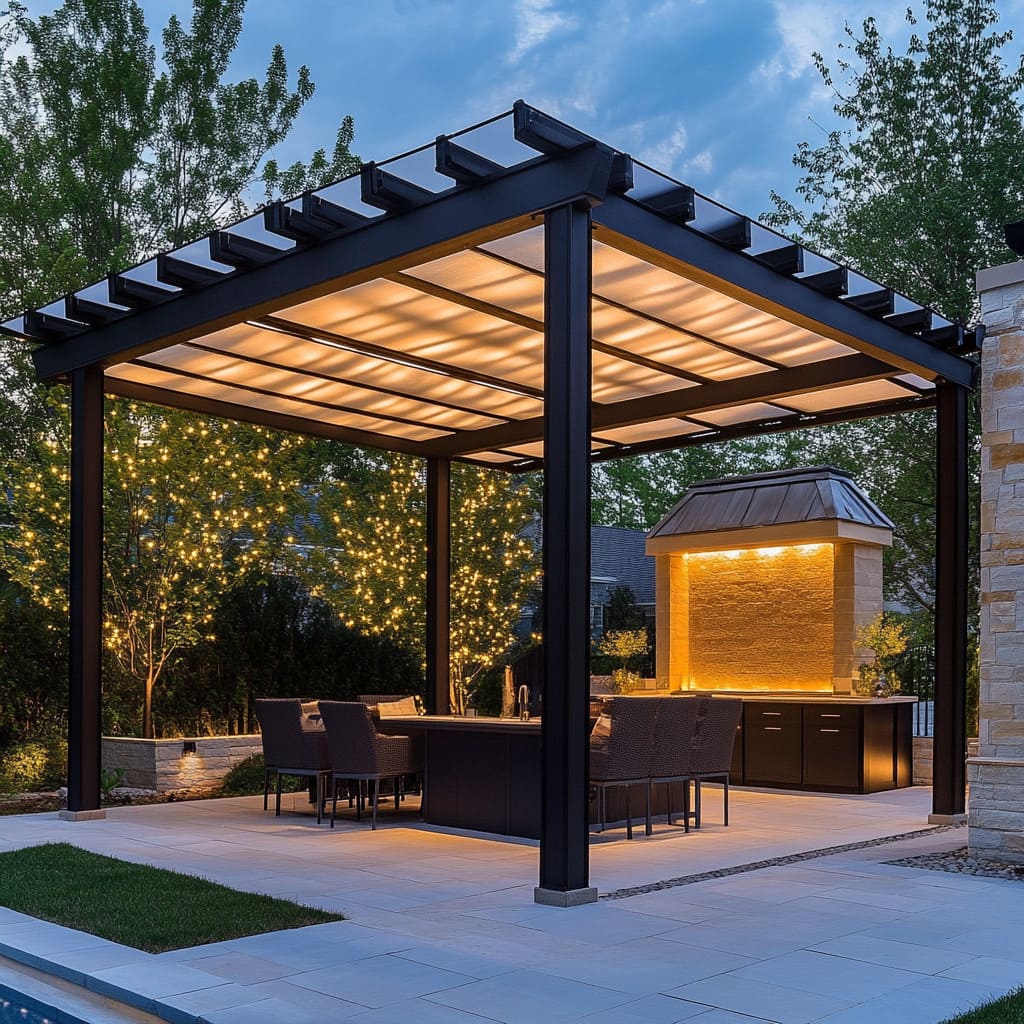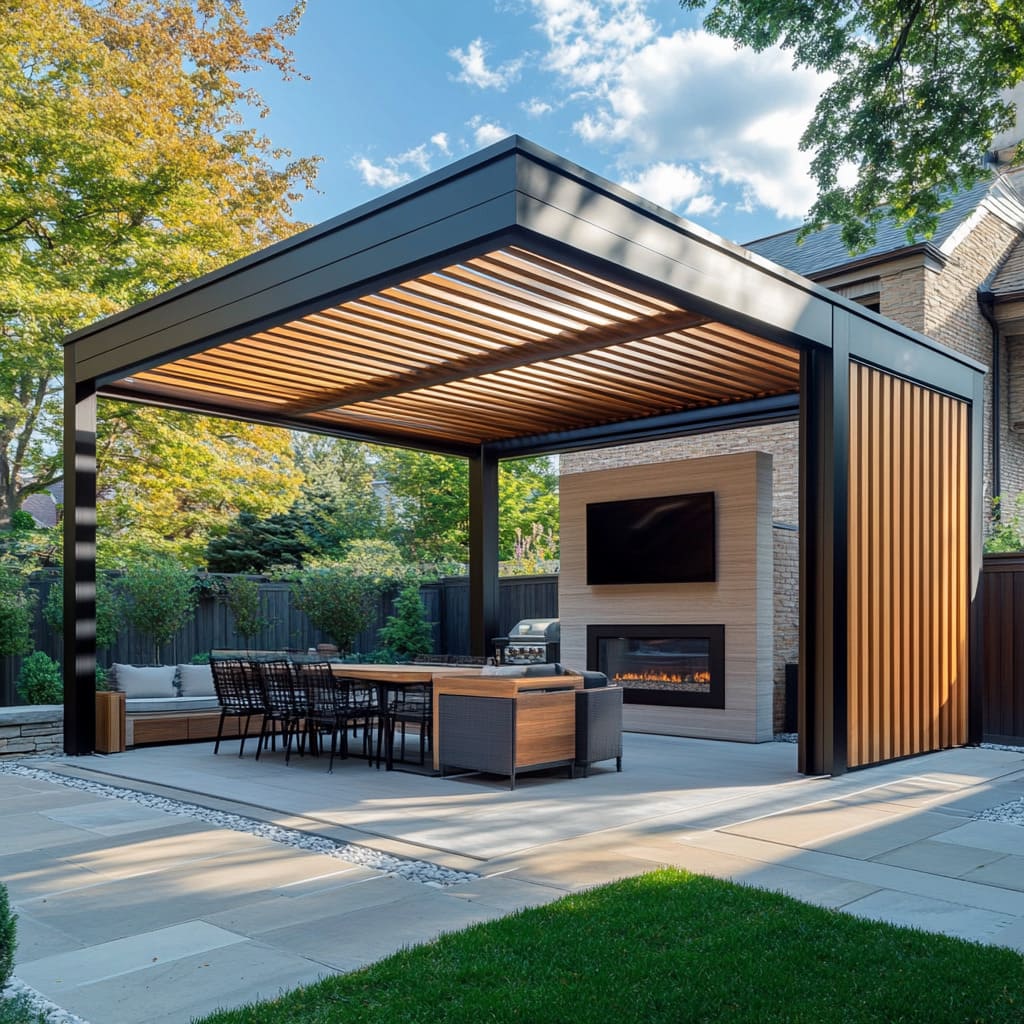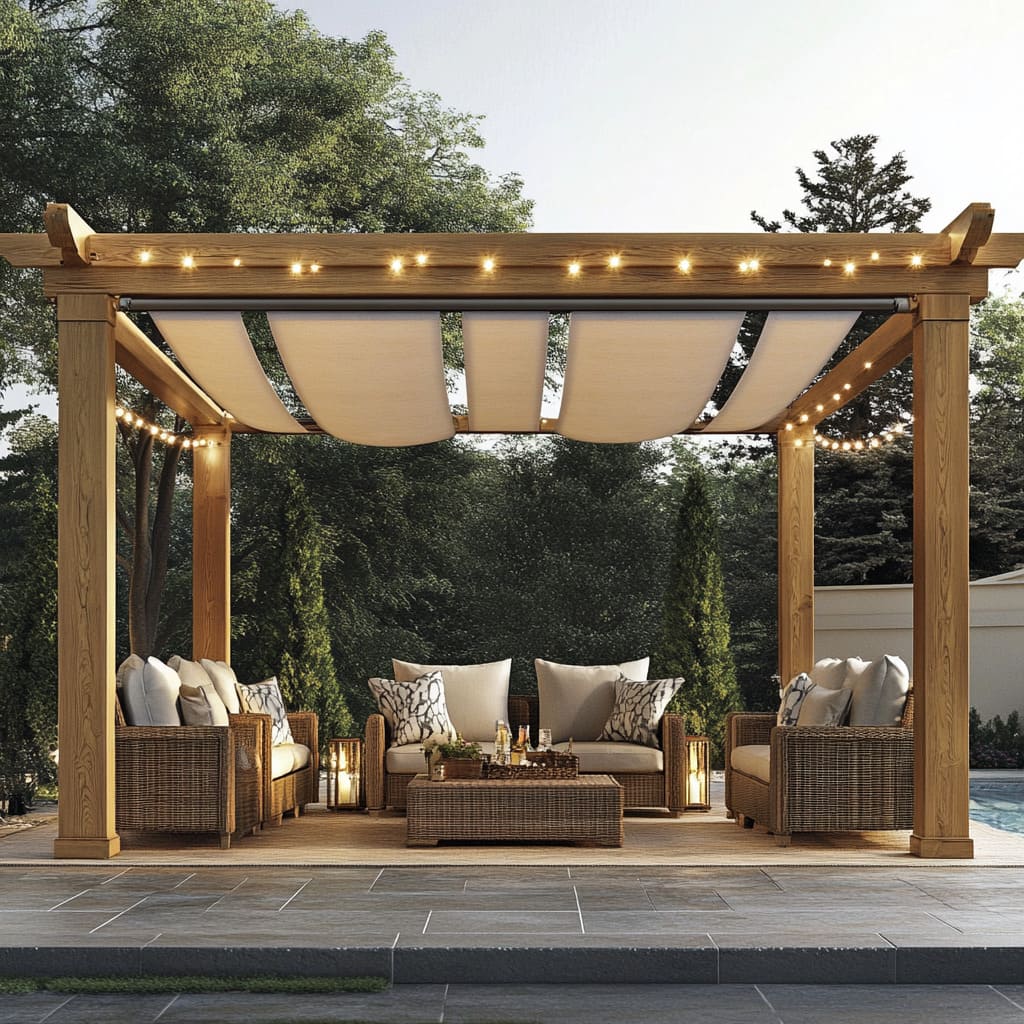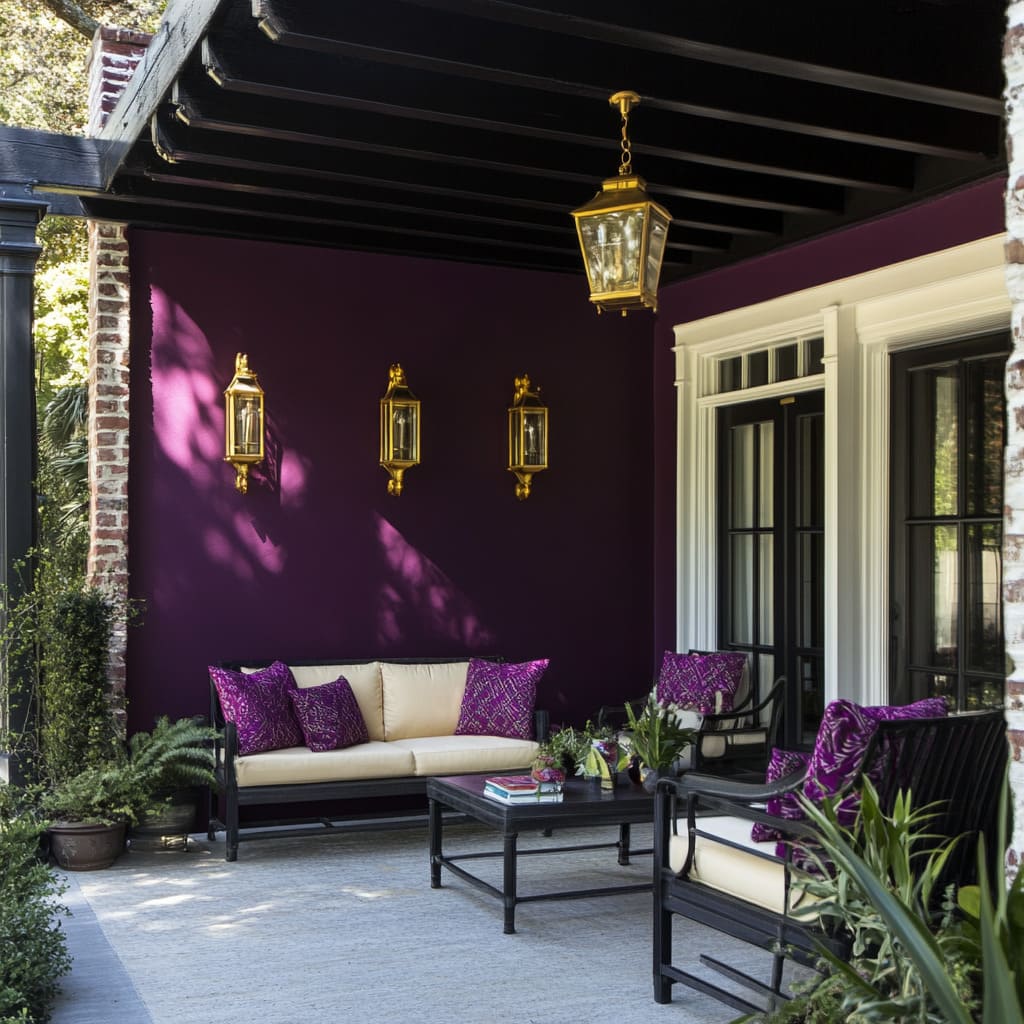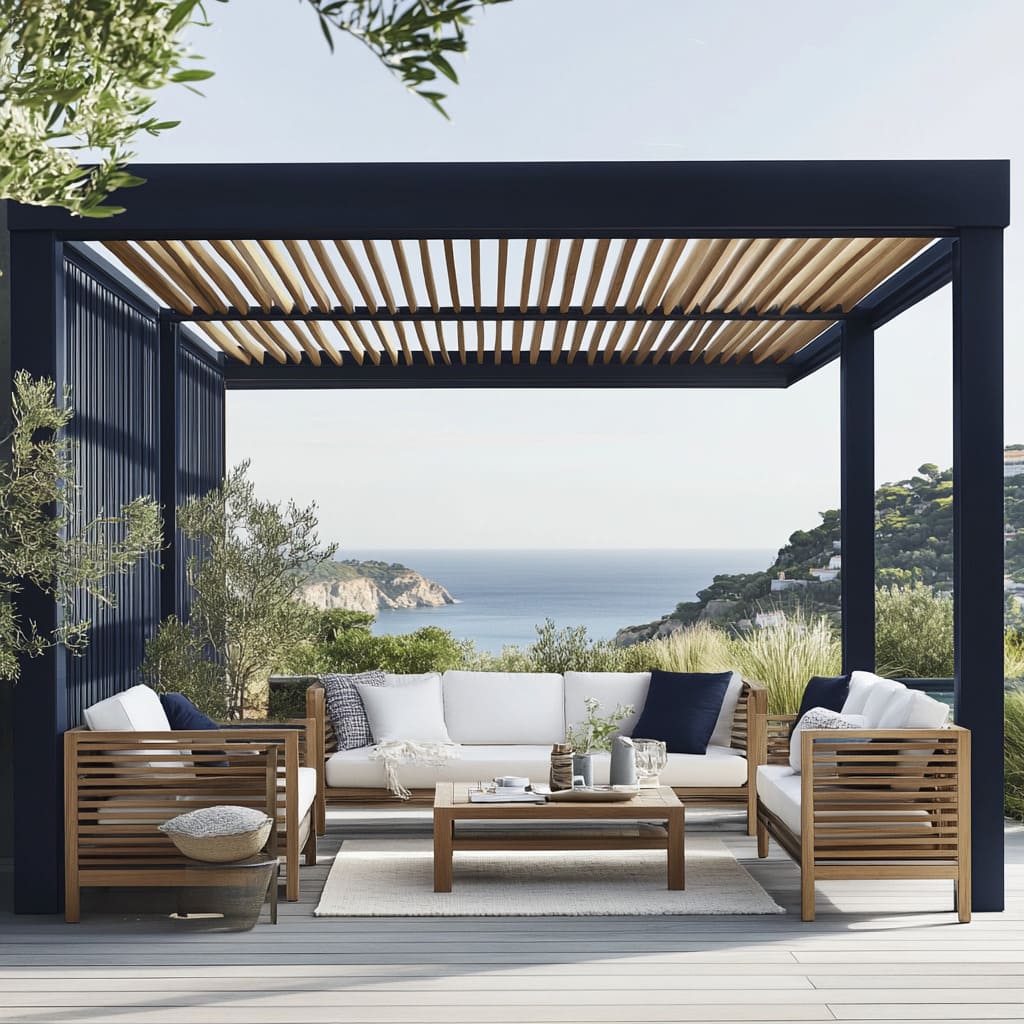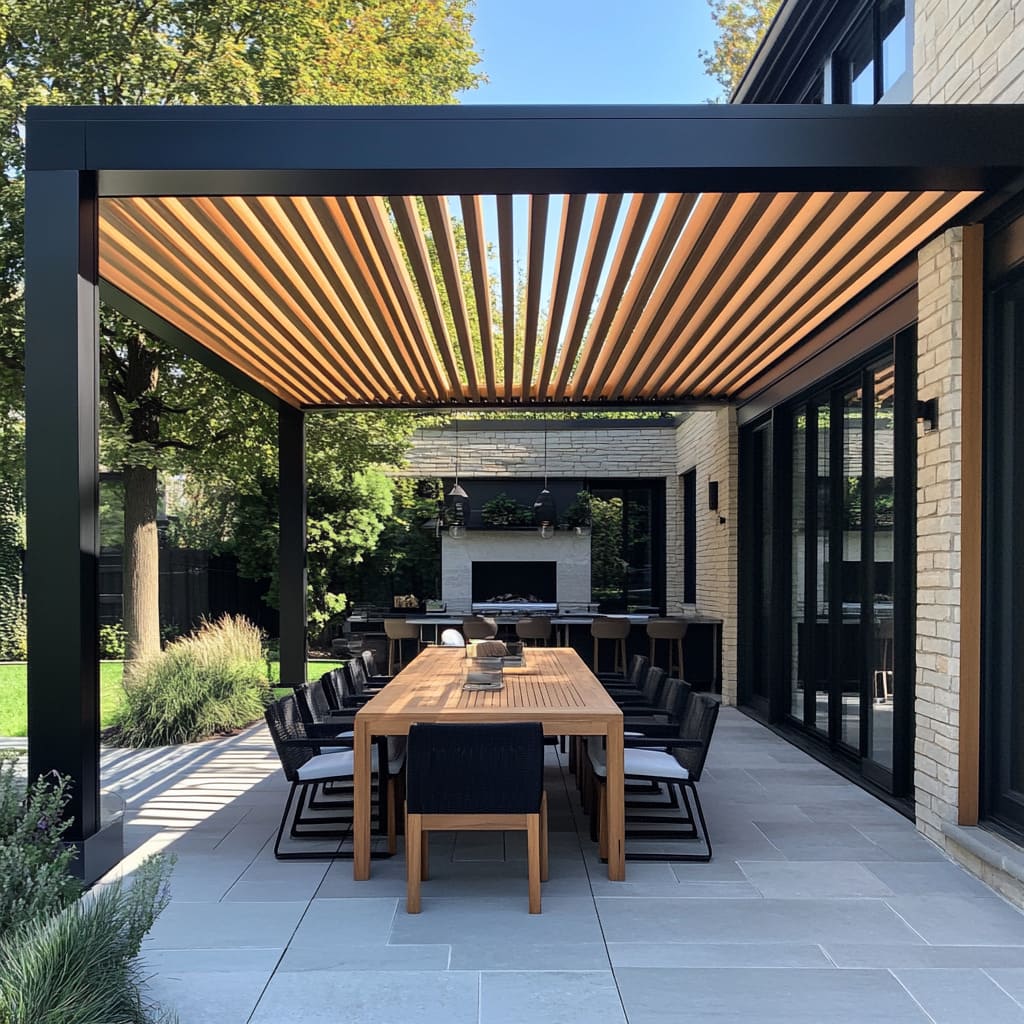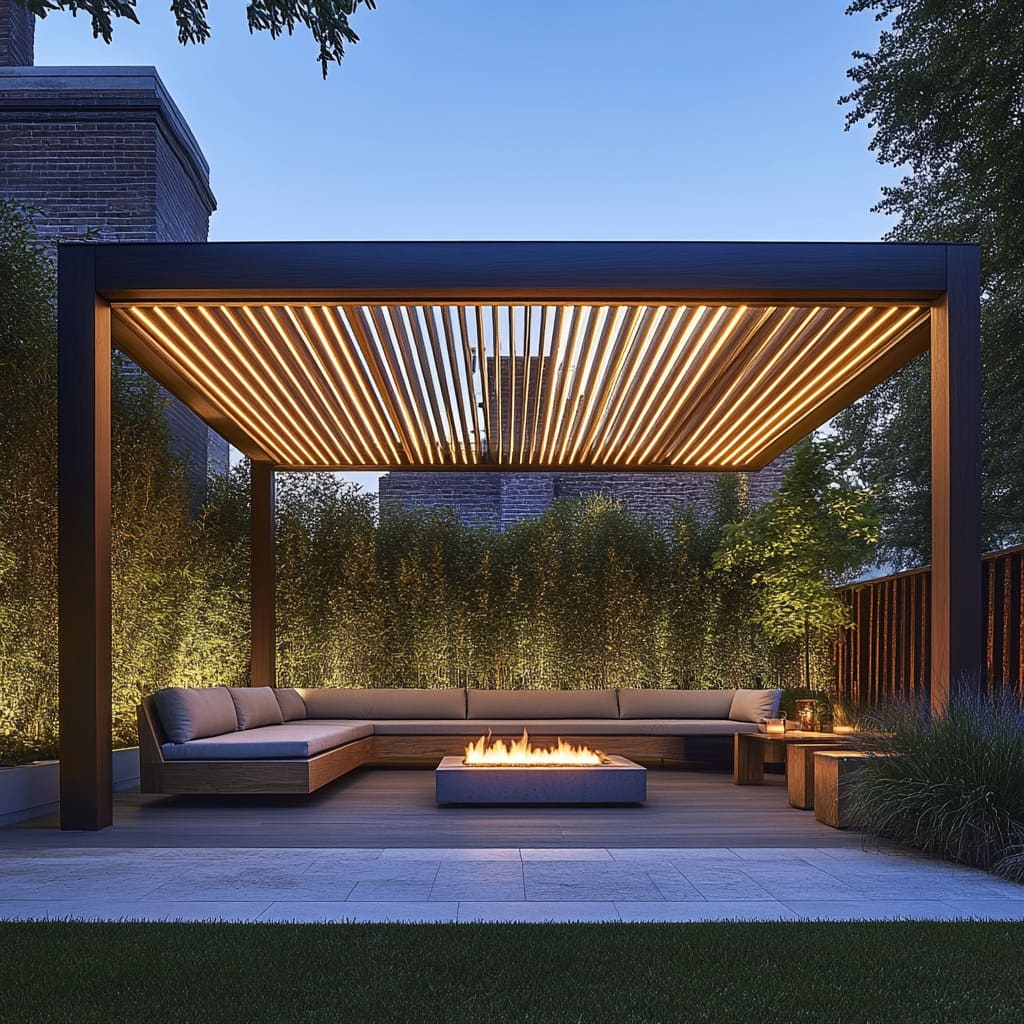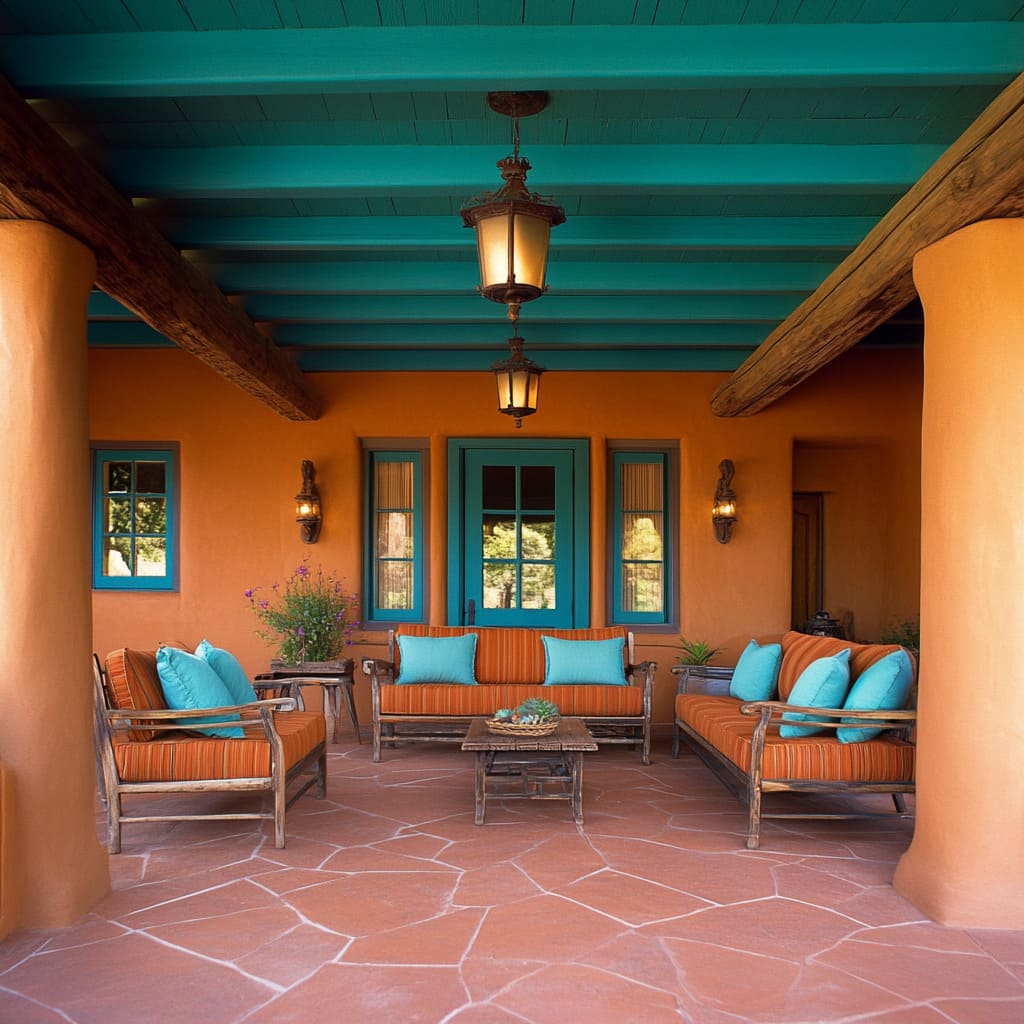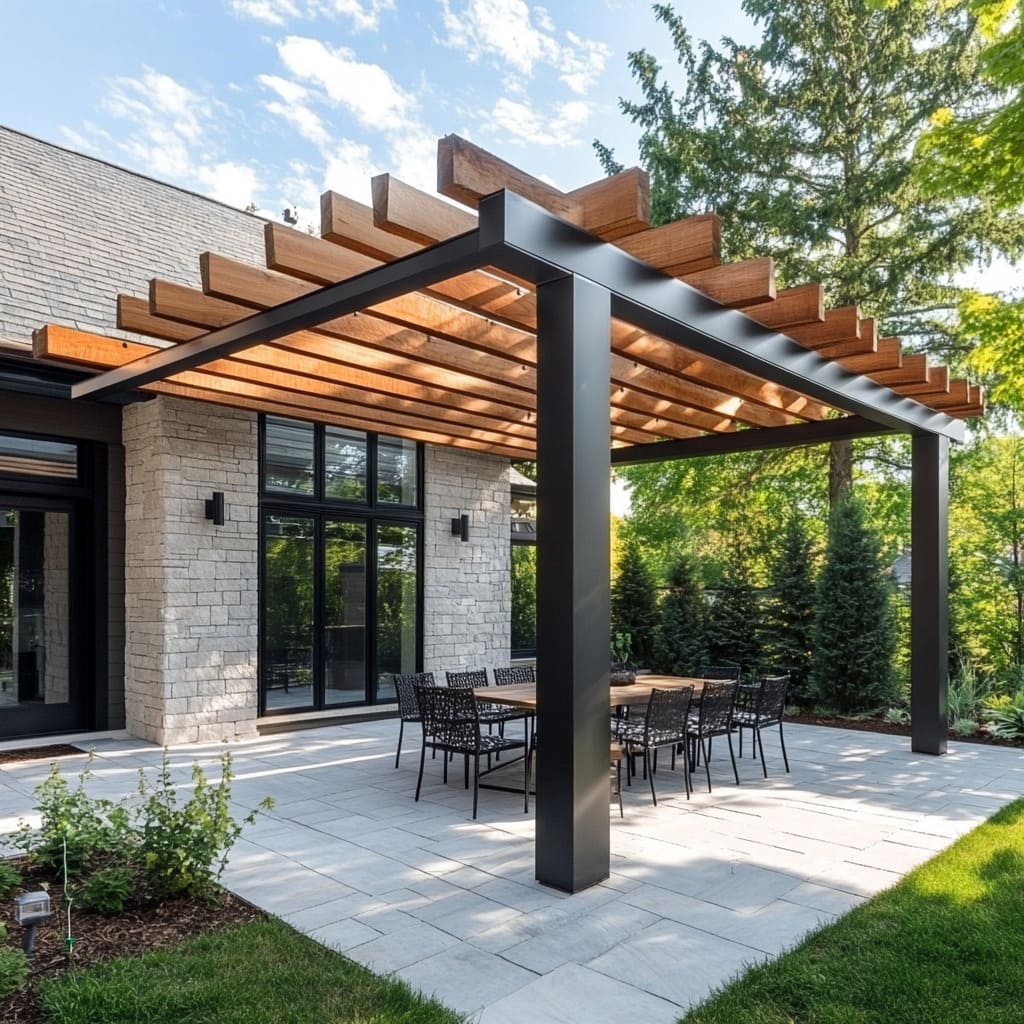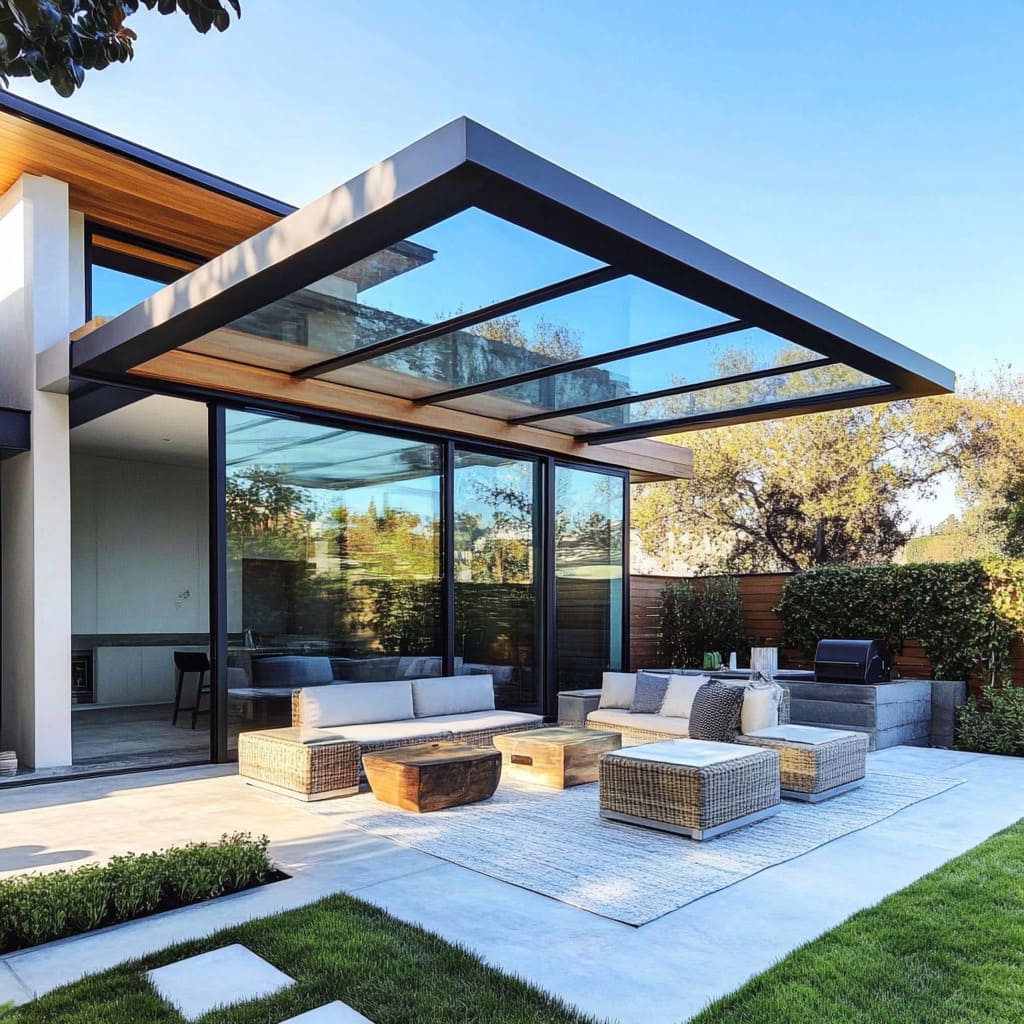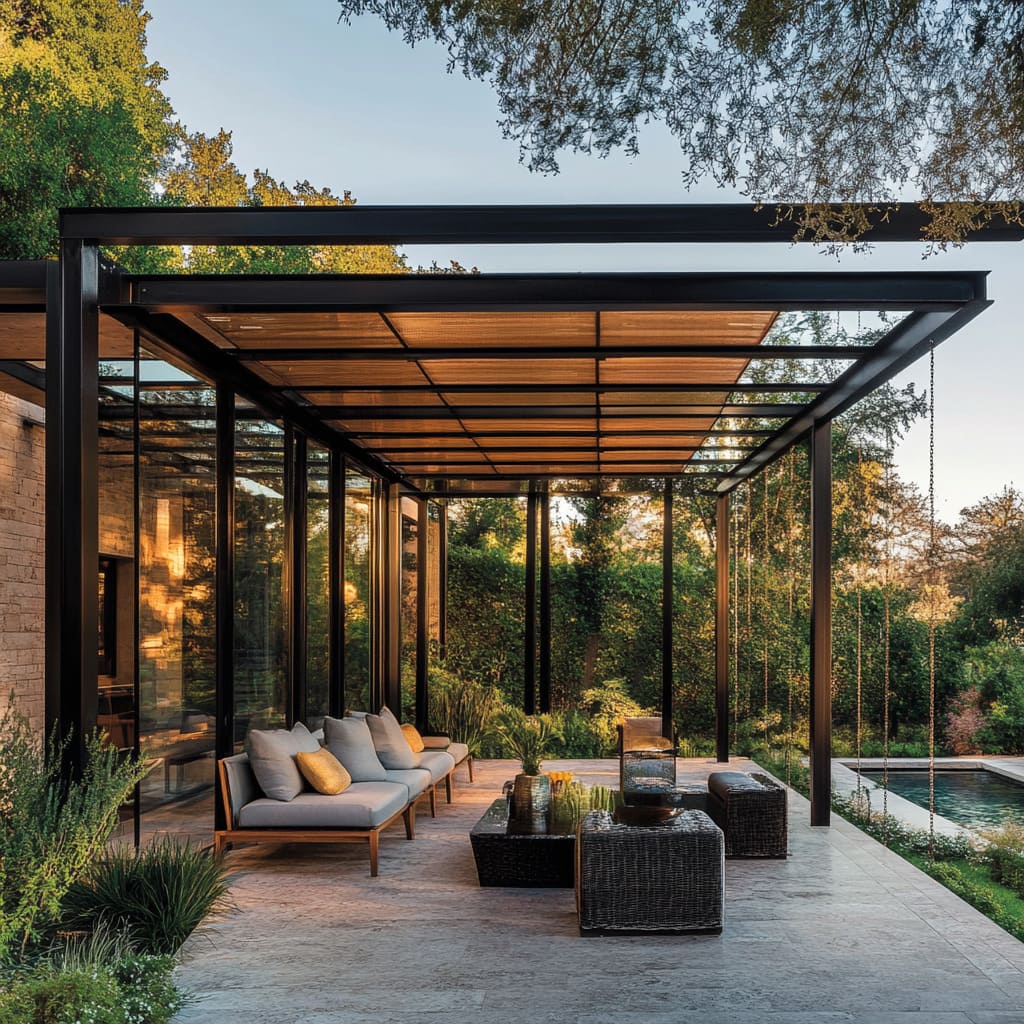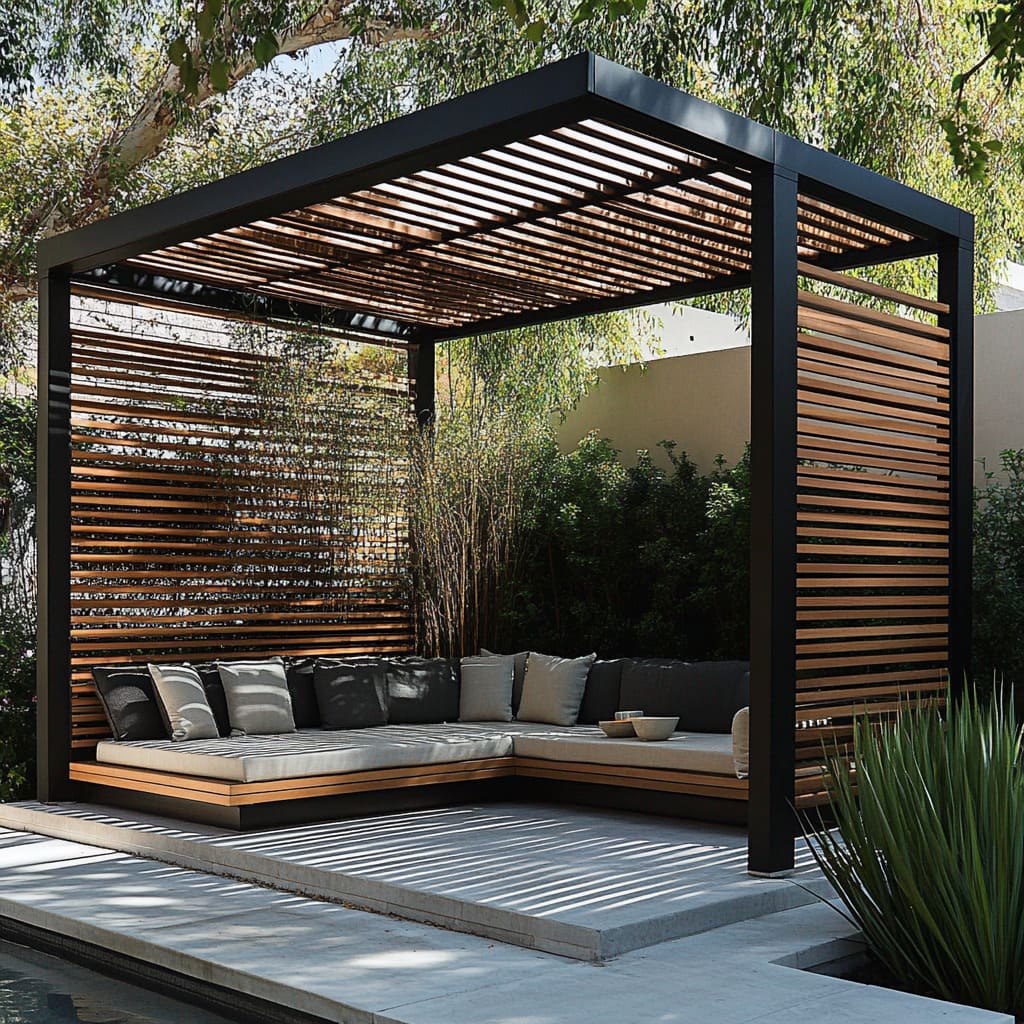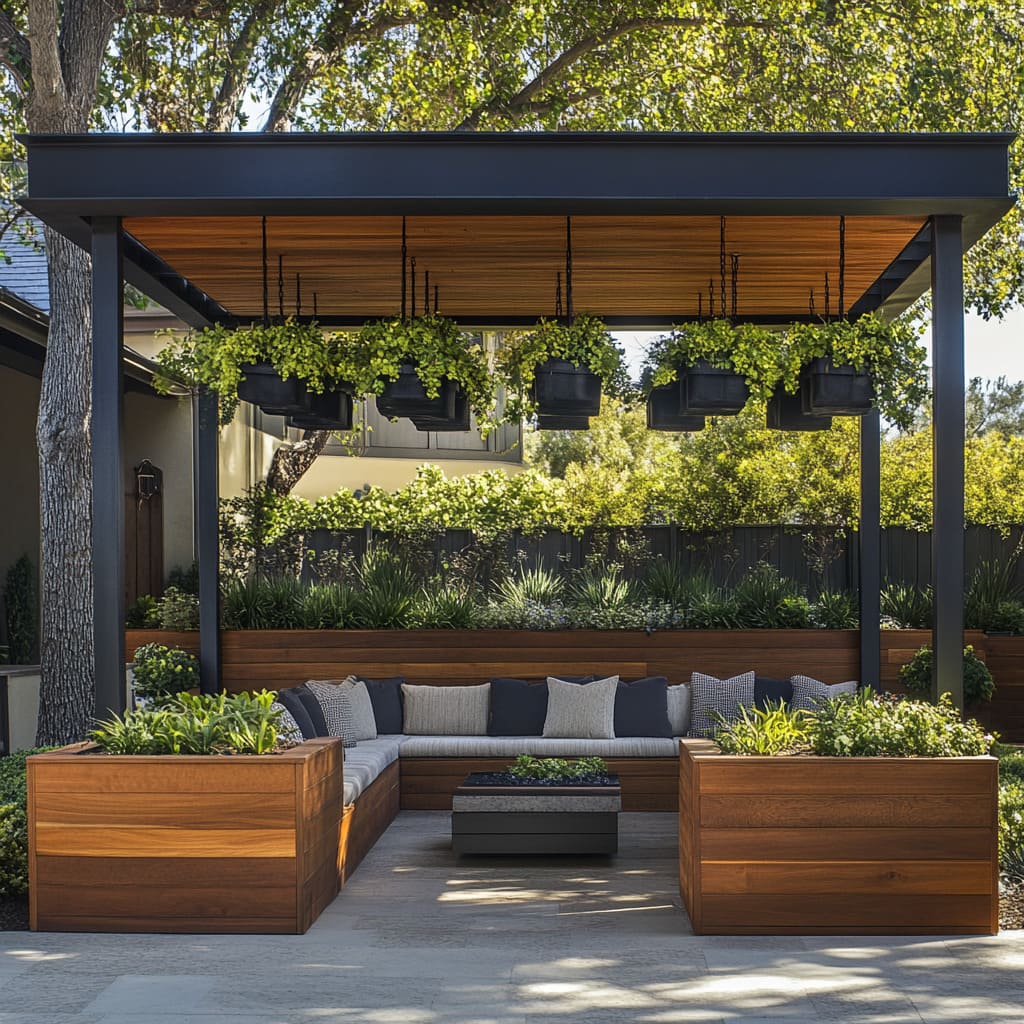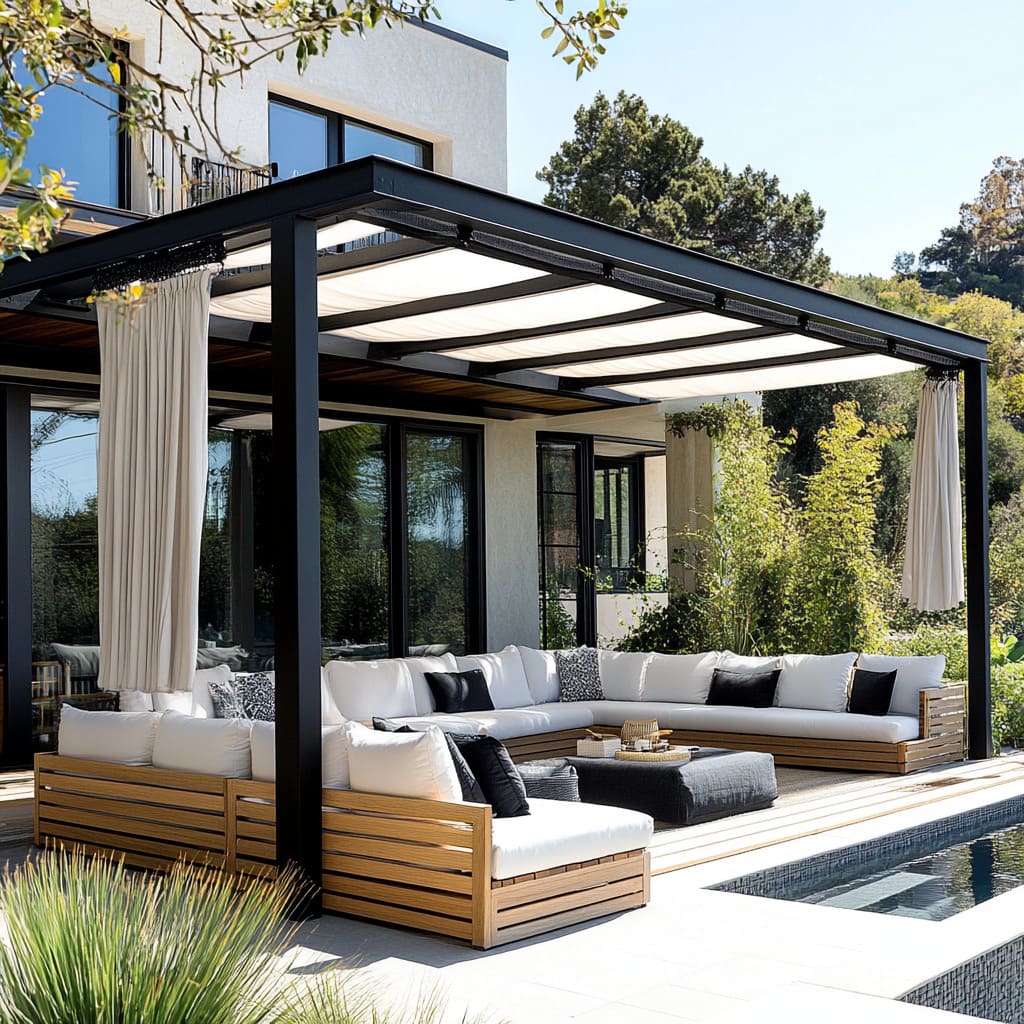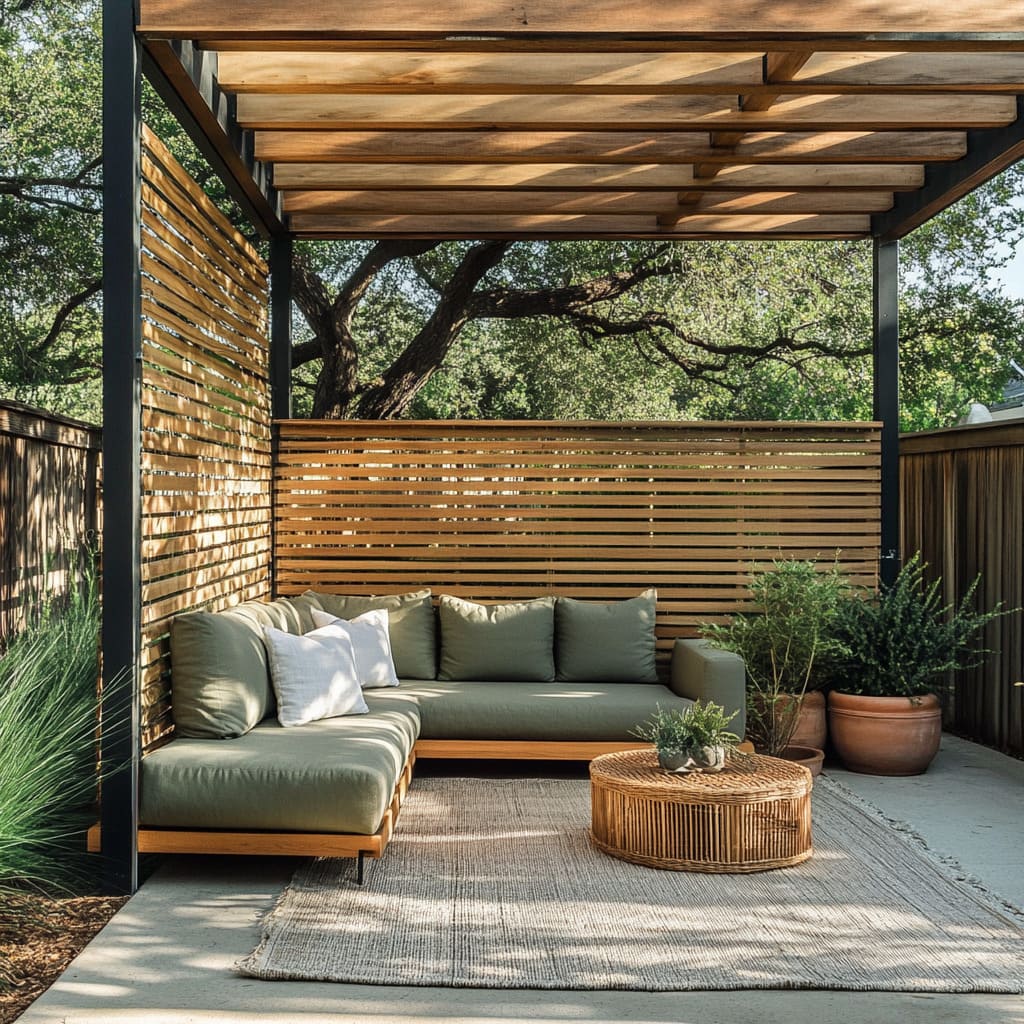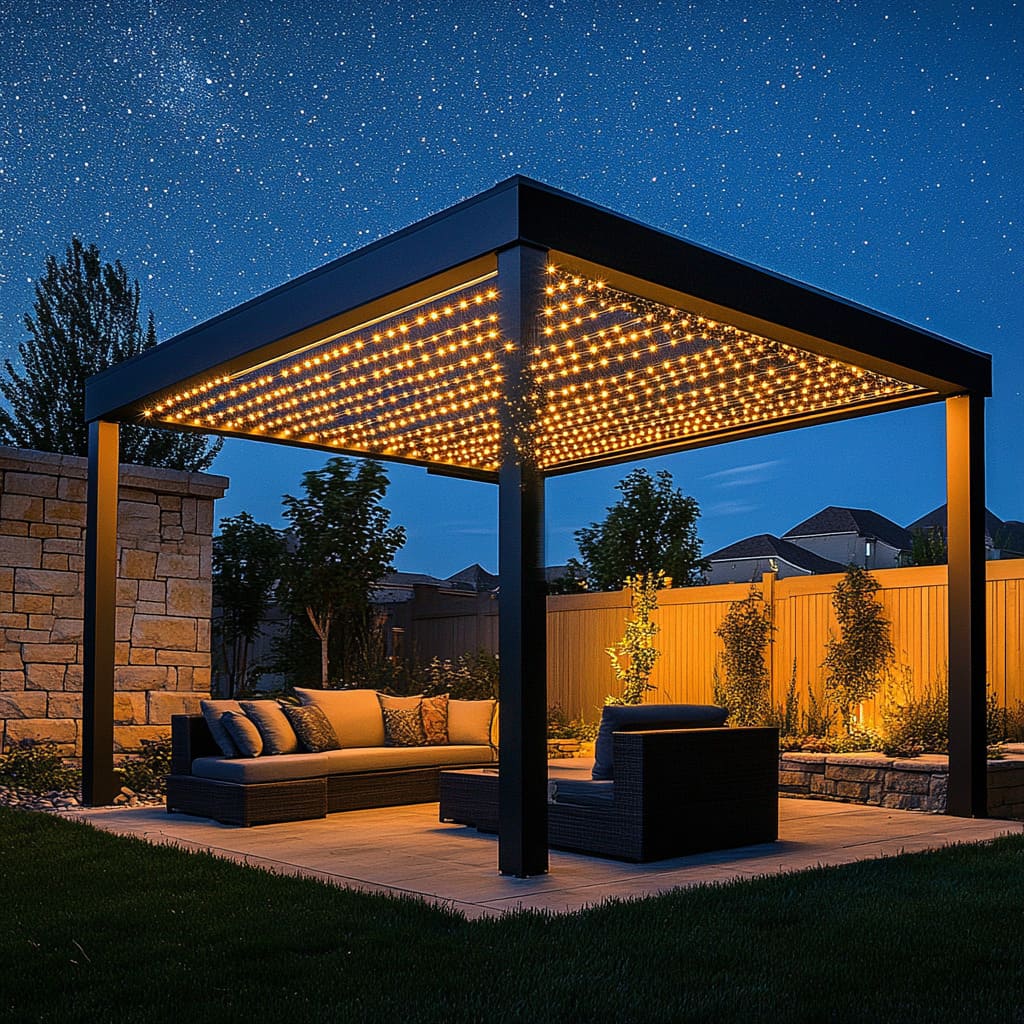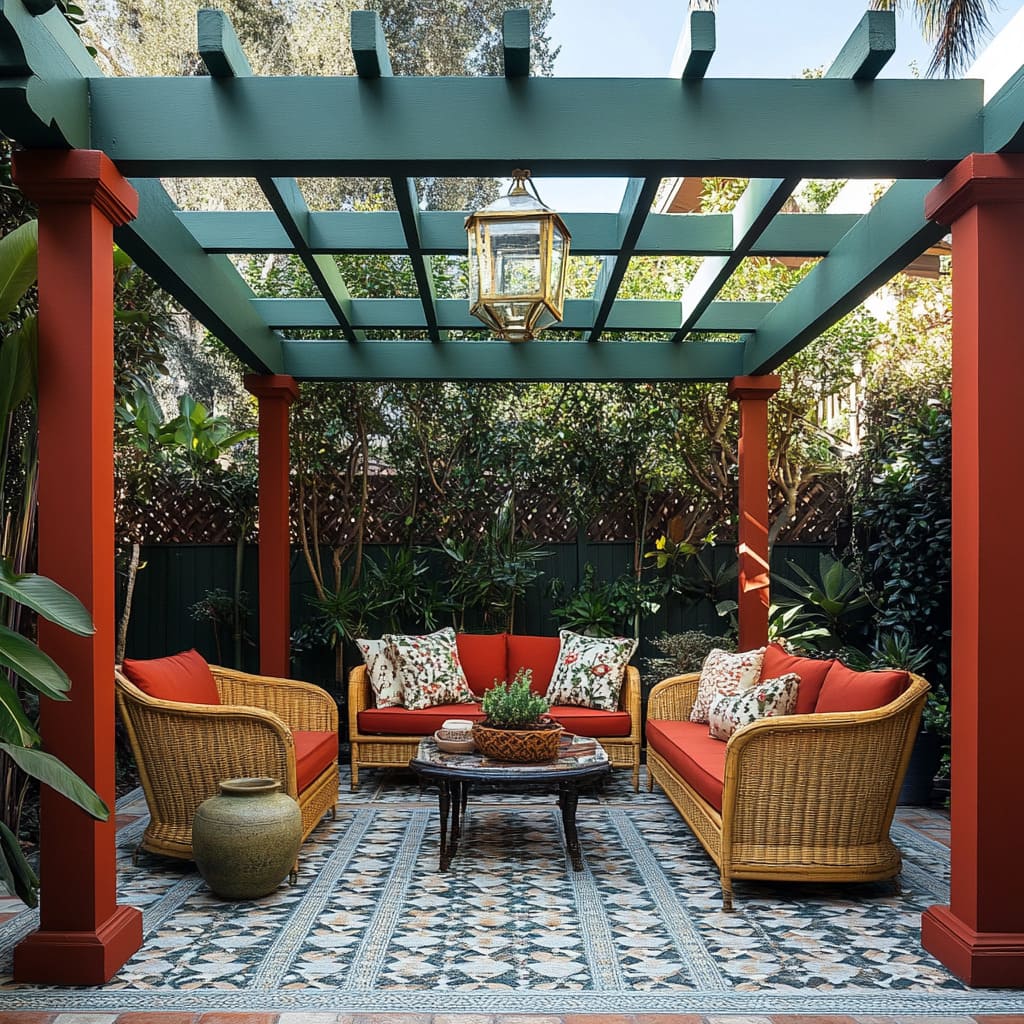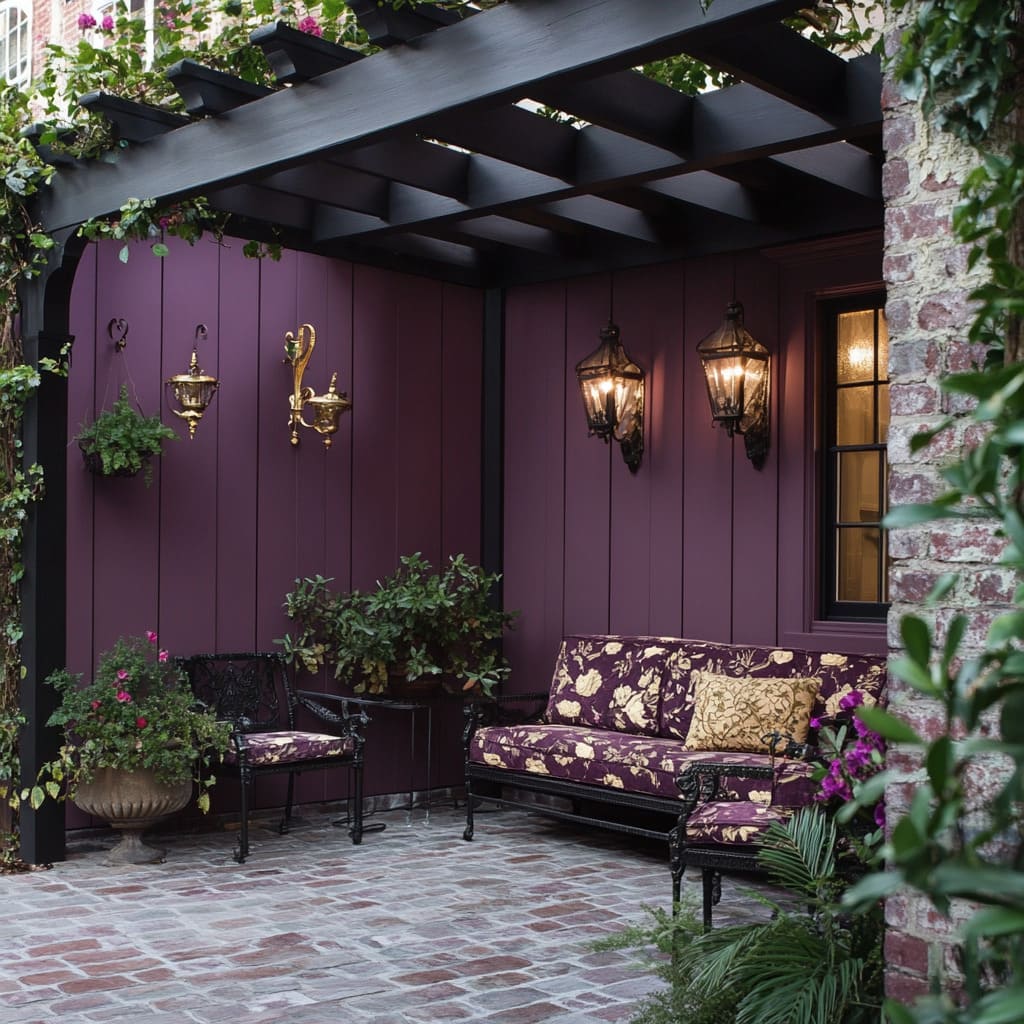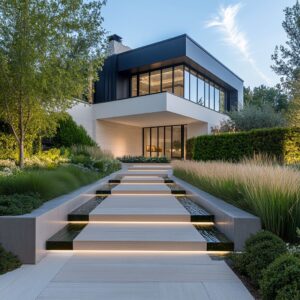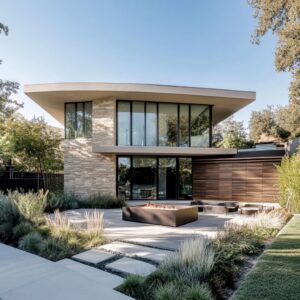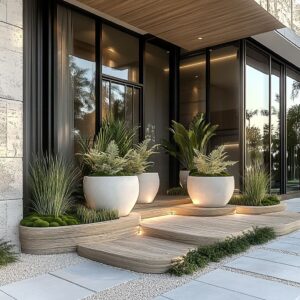Patio canopies do more than provide shade—they set the tone for an outdoor space, shaping both comfort and style. While many designs focus on structure and materials, the finer details often make the biggest difference.
This deep dive into patio canopy ideas goes beyond the usual observations, highlighting features that aren’t always obvious at first glance. From the way shadows shift through slatted wood panels to the subtle role of reflections in glass canopies, these elements create a more dynamic and inviting space.
The choice of frame materials, the integration of lighting, and even the way greenery interacts with the structure can completely change how a patio feels throughout the day. Some designs focus on an airy, floating effect, while others use bold contrasts to create a striking focal point.
Another layer of interest comes from lighting strategies—hidden LED strips embedded along canopy edges can add warmth without harsh glare, while fiber-optic details mimic a starry night. Fabric-draped canopies introduce a softer, more fluid aesthetic, offering an option that adapts to shifting light conditions.
By looking at these finer details, it becomes clear that a well-planned canopy isn’t just an overhead shelter. It can frame a space, control the ambiance, and enhance the connection between architecture and nature.
Whether inspired by Mediterranean courtyards, modern minimalist retreats, or lush urban gardens, the possibilities stretch far beyond a simple covering.
Material Combinations & Structural Nuances
The materials chosen for a patio canopy do more than shape its look—they define its durability, function, and how well it blends with its surroundings. While many designs rely on a mix of wood, metal, and glass, the way these elements interact plays a huge role in the final outcome.
The right combination can make a space feel grounded and inviting, or sleek and striking. Whether inspired by industrial lofts, modern retreats, or classic outdoor havens, the mix of materials influences everything from the way light filters through to how the structure interacts with the landscape.
Contrasting Frames and Slats
One of the most effective ways to create depth in a canopy design is through contrast. Many modern outdoor structures use dark metal framing with lighter wood slats, balancing industrial sharpness with warmth.
This contrast doesn’t just highlight the materials—it helps define the structure’s edges, making the canopy feel both sturdy and visually light. A key consideration is scale and proportion.
A canopy with an overwhelming amount of dark metal can feel too heavy, while one with too much light-toned wood might lack definition. The best designs create harmony by incorporating multiple wooden layers—roof slats, partial side panels, or even built-in seating that echoes the overhead structure.
This layering softens the rigid look of metal while reinforcing a unified aesthetic. In some cases, introducing a few vertical wooden elements along the sides adds warmth, preventing the space from feeling too stark.
Mixing Industrial and Natural Textures
Pairing industrial-strength steel with organic wood textures brings a sense of balance. Metal elements such as slim brackets, exposed bolts, or structured beams give a sense of durability, while wood keeps the space feeling welcoming.
Many of these design choices aren’t just for structure—they can also be decorative. A small but significant detail is the finish of the metal.
A smooth, powder-coated black steel frame creates a crisp, modern look, while a slightly aged or patinated finish allows the metal to blend more naturally with wood. Some designs incorporate brushed steel or matte-finish elements, reducing glare and making the contrast feel more refined.
Beyond wood and metal, some canopies integrate stone or concrete in seating, flooring, or support columns, further enhancing the mix of materials. This is often seen in outdoor spaces inspired by urban courtyards or rustic retreats, where combining natural and industrial elements brings a layered, dynamic feel.
Fusion of Glass and Wood
Glass is often used in patio canopies for its ability to maintain openness while offering protection. A glass roof framed with wood allows natural light to pour through while still providing partial shade when paired with wooden slats beneath.
This combination works particularly well in settings where outdoor greenery plays a significant role, as reflections in the glass can subtly blend the canopy with its surroundings. However, reflections aren’t just an aesthetic element—they influence how a space feels.
In areas with lush trees or open sky views, glass amplifies the sense of connection to nature. The way light moves through transparent panels can make a space feel different at various times of the day, adding a dynamic quality.
Another advantage of integrating glass into wooden canopies is weather protection. Unlike fully slatted roofs that allow some rain to pass through, glass keeps the space dry while still letting sunlight filter in.
This is particularly useful in climates where frequent drizzles would otherwise limit outdoor usability.
Cantilevered and Floating Appearances
Some patio canopies take a more daring approach with cantilevered or floating designs, extending beams or glass panels beyond the main support points. This creates an effect where the structure feels weightless, making it seem as though the canopy is hovering above the space rather than resting on visible columns.
Achieving this illusion requires careful engineering. Many floating canopies conceal steel reinforcements within wooden beams or rely on angled bracing hidden behind adjoining walls.
This not only ensures stability but also allows for longer overhangs, maximizing coverage without additional support posts cluttering the space. Beyond aesthetics, there’s a functional advantage—slightly angled cantilevered edges help with water runoff, directing rain away from seating areas.
This is particularly useful in patio sun shade ideas where maintaining a dry, shaded space is just as important as the overall look. The floating effect can also be enhanced with strategic lighting.
LED strips placed under extended beams or along glass edges create an ambient glow, making the structure feel even lighter after sunset. This technique works especially well with minimalist designs where clean lines and unobtrusive supports are key to the aesthetic.
The materials and structural choices behind a patio canopy aren’t just about durability—they define how a space looks, feels, and functions throughout the day. Whether it’s a contrast of wood and steel, the reflective quality of glass, or a carefully engineered floating design, these elements add layers of depth and personality.
By balancing textures, proportions, and finishes, a patio canopy can become an architectural feature that enhances both the home and the outdoor experience.
Lighting Beyond the Ordinary
Lighting does more than illuminate an outdoor space—it defines mood, highlights architectural details, and adds depth to a patio canopy. Whether it’s subtle recessed LEDs, statement pendant lights, or an arrangement that mimics the night sky, the right lighting transforms a canopy from a simple structure into an inviting outdoor retreat.
By carefully choosing placement, color temperature, and intensity, it’s possible to create a space that feels just as inviting after sunset as it does during the day.
Recessed and Perimeter LED Strips
One of the sleekest ways to light a canopy is with LED strips placed along its inner frame. This setup creates soft, indirect illumination that highlights materials like wood and metal without exposing harsh bulbs.
Unlike traditional overhead fixtures, this type of lighting blends into the structure itself, enhancing the overall look rather than competing with it. LED strips can be warm-toned for a cozy feel or cooler for a crisp, modern effect.
Some setups include dimmable options or even color-changing features that allow the lighting to shift based on mood or time of day. However, the placement of these lights matters just as much as their brightness.
If positioned too close to the outer edges, they can create an unintended glowing border that might be visible from the street or upper floors of a nearby house. A more subtle approach is embedding them deeper within the canopy frame or spacing them at intervals to create a diffused effect.
For canopies with wooden slats, LEDs positioned between them can create a striking interplay of light and shadow, casting linear patterns onto the seating area below. This works particularly well in garden canopy ideas that incorporate natural materials, as the lighting enhances the organic warmth of the wood while still keeping the space functional at night.
Hanging Fixtures and Pendant Lamps
Pendant lighting is an easy way to introduce personality into a patio canopy, whether through sculptural modern designs or rustic woven shades. Unlike recessed lights, which focus on a soft glow, pendants add more directionality, allowing for zones of brightness that can highlight key areas, like a dining table or lounge setup.
The height of these fixtures plays a major role in the atmosphere they create. A cluster of pendant lights at varying heights adds visual interest, while evenly spaced fixtures create a balanced, structured look.
When combined with wooden slats or beams, pendants can either hang freely or be integrated into the framework, blending the lighting seamlessly into the structure. For canopies with an open-roof design, where slats allow sunlight to filter through, pendant lighting can take on a layered effect.
During the day, the natural light creates shifting patterns, while at night, the hanging lights cast a soft downward glow, maintaining a similar interplay of light and shadow. If a space feels too rigid or formal, using fixtures with woven rattan or textured glass can introduce warmth and soften the overall aesthetic.
Fiber-Optic or Star-like Effects
For those who want an outdoor space that feels more immersive, fiber-optic lighting offers a unique way to mimic a starry night sky. This type of lighting consists of small pinpoint LEDs or fiber-optic strands embedded into a canopy’s ceiling, creating the illusion of a softly glowing constellation overhead.
This approach works especially well in areas with low ambient light, where the delicate sparkle stands out against the darkness. It’s a popular choice for pergolas and partially enclosed canopies, as the effect feels more pronounced in spaces that don’t have competing streetlights or indoor glow from nearby windows.
The key to pulling off this look is thoughtful installation. Fiber-optic strands need a well-planned setup, with hidden conduits running above the canopy to keep wiring neat.
Since the individual points of light are so small, they can be arranged in specific patterns, from random clusters that mimic a real night sky to symmetrical layouts that add a touch of design precision. Another option is combining fiber-optic lighting with a semi-transparent canopy material.
When installed beneath lightly frosted glass or a sheer fabric layer, the tiny lights appear diffused, making the effect even more atmospheric. This is especially effective for those who want subtle lighting that doesn’t overpower the surrounding environment.
Lighting is just as important as the materials in shaping the overall experience of a patio canopy. Whether it’s the soft glow of recessed LEDs, the defined warmth of pendant lights, or the twinkling effect of fiber optics, each approach adds a different dimension to the space.
By carefully selecting the right placement, brightness, and materials, a canopy becomes more than just a shaded retreat—it turns into an outdoor setting that feels welcoming and visually engaging long after the sun goes down.
Color Palettes with Strategic Impact
The color of a patio canopy does more than define its style—it shapes the entire atmosphere of the outdoor space. Whether bold and eye-catching or soft and neutral, the right color palette can influence the way light interacts with the structure, how the furniture complements the setting, and even the overall sense of openness or coziness.
Some designs lean into vibrant tones, making the canopy a statement piece, while others rely on subtle shades that blend effortlessly with the surrounding landscape. The key is knowing how to balance color choices for the right effect.
Bold vs Muted Color Choices
Some patio canopies embrace strong colors, instantly drawing attention and setting the tone for the space. Deep burgundy, rich navy, mustard yellow, and forest green are just a few examples of shades that can transform a simple structure into a focal point.
These choices work particularly well in designs inspired by Mediterranean courtyards, bohemian escapes, or artistic modern outdoor spaces, where color plays an essential role in defining the aesthetic. A bright overhead canopy can serve as a visual anchor, pulling attention upward and making the outdoor space feel larger.
On the other hand, a richly painted backdrop, such as a deep green or terracotta wall behind the canopy, can guide the eye horizontally, creating a cozy and intimate setting. For those who prefer a more natural look, neutral tones allow the canopy to blend seamlessly with its surroundings.
Stained wood, off-white, soft grays, and taupe shades keep the focus on textures rather than color, making the space feel timeless and adaptable. These tones work especially well in modern and Scandinavian-inspired backyard canopy ideas, where simplicity and natural materials are key design elements.
A balanced approach combines both bold and neutral elements. For example, a canopy in a strong color can be softened with neutral flooring and furniture.
Conversely, a neutral-toned canopy can gain visual interest by introducing bold furniture or accessories, preventing the space from feeling too monochromatic.
Coordinating Fabric Colors and Canopy Accents
The relationship between the canopy color and the furniture underneath plays a major role in the overall look. One effective technique is selecting upholstery and cushions that either match or subtly contrast with the canopy’s tone.
This creates a sense of depth and cohesion without overwhelming the space with too many competing colors. For a sophisticated layered effect, a tone-on-tone approach works well.
If the canopy is a deep navy, choosing throw pillows in a slightly lighter or darker version of the same color keeps the look refined while adding dimension. Another option is to incorporate patterned textiles that echo the canopy’s shade in small doses—geometric prints, stripes, or abstract designs can help connect the structure to the seating area below.
Textured fabrics, such as woven rattan, linen, or weather-resistant canvas, add another layer of interest, especially when paired with wooden canopy frames. The contrast between structured canopy beams and softer textiles prevents the space from feeling too rigid while maintaining a cohesive color story.
Color has a huge impact on how a patio canopy shapes the outdoor experience. Whether the goal is to create a striking focal point with bold hues or to keep things understated with neutral tones, the right balance of shades and textures ensures the space feels inviting.
By carefully coordinating the canopy, furniture, and surrounding elements, the outdoor area becomes not just a functional retreat but a visually engaging extension of the home.
Integrated Features: From Waterfalls to Firepits
A patio canopy isn’t just about shade—it can be the foundation for a fully immersive outdoor space. By incorporating fire, water, and cooking elements, a canopy becomes more than a structure overhead—it turns into an experience.
Whether designed for warmth on cool evenings, a refreshing retreat in warm weather, or an entertainment hub, these additions elevate a canopy from a simple cover to the centerpiece of an outdoor living area.
Fire Elements
Few things make an outdoor space feel as inviting as a firepit or fireplace. More than just an aesthetic feature, fire draws people in, creating a cozy, communal atmosphere.
A well-placed firepit naturally becomes the heart of a seating arrangement, encouraging conversation and relaxation. However, when combining fire with a canopy, ventilation is critical.
Wood or fabric-covered structures need to account for smoke dispersion. Slatted openings above the fire area can prevent smoke buildup while maintaining airflow.
For enclosed or semi-enclosed canopies, built-in ventilation systems or taller chimneys help direct smoke upward without trapping heat. Material choice also plays a role.
If the canopy has metal beams, the proximity of the firepit needs careful planning to prevent heat-related warping. Some designs integrate fire-resistant stone or concrete surfaces around the fire area, providing both protection and a seamless transition between elements.
For a modern touch, gas-powered firepits eliminate smoke issues altogether while still providing the warmth and ambiance of an open flame. This is especially useful for more enclosed canopies where traditional wood-burning firepits might create lingering smoke.
Waterfalls and Reflecting Pools
Water elements are less common than fire features, but when used strategically, they can redefine the atmosphere of a patio canopy. A reflecting pool or cascading waterfall introduces both a cooling effect and an ambient soundscape, softening the overall feel of the space.
A water curtain—where a thin sheet of water flows from a canopy’s edge into a basin below—can serve as both a visual divider and a subtle temperature regulator. The movement of water lowers the surrounding temperature, making it especially useful for hot climates.
The sound of flowing water also helps mask background noise, making a patio feel more secluded, even in an urban setting. Maintenance is a major consideration.
Unlike a standard canopy, integrating water requires filtration, pumps, and discreet drainage solutions to keep the system running smoothly. Filters prevent mineral buildup, while properly designed drainage ensures water doesn’t pool in unwanted areas.
At night, lighting plays a key role in amplifying the effect of a water feature. Backlit waterfalls or submerged LED strips can create shimmering reflections on the canopy above, enhancing the overall ambiance.
Even simple uplighting placed behind a reflecting pool can make the space feel more dynamic once the sun goes down.
Outdoor Kitchens and Bars
For those who entertain frequently, an outdoor kitchen under a canopy extends the home’s living space beyond its walls. These setups range from compact bar counters to fully equipped cooking stations, complete with grills, sinks, and prep areas.
The canopy itself acts as a natural extension of the home’s kitchen, but integrating cooking appliances comes with a few challenges. Ventilation is crucial—whether for a grill, pizza oven, or smoker, proper airflow prevents heat and smoke from collecting under the structure.
Open-louvered roof panels help release cooking smoke, while retractable glass walls allow flexibility in how enclosed or open the space feels. Material selection is equally important.
Heat-resistant countertops like stone, stainless steel, or concrete work best for prep areas, ensuring durability under high temperatures. Flooring should also be slip-resistant, particularly if the space is prone to splashes from a nearby sink or beverage station.
For smaller spaces, a simple built-in bar with a counter-height ledge can create a social hub without requiring the full infrastructure of a kitchen. Adding bar stools and integrated lighting transforms a corner of the patio into a casual, welcoming space for guests.
A patio canopy is more than a cover—it’s an opportunity to blend natural elements with modern functionality. Firepits create warmth and a gathering point, water features bring movement and sound, and outdoor kitchens turn a simple seating area into a full-fledged entertainment space.
With the right planning, a canopy becomes the foundation for an outdoor setting that’s as inviting as any indoor living space, seamlessly blending comfort, practicality, and design. Whether drawn to the warmth of a fire, the cool touch of a waterfall, or the convenience of an outdoor cooking station, these outdoor canopy ideas offer endless ways to craft a space that’s both stylish and functional.
Creative Uses of Fabric and Drapery
Fabric is one of the most versatile elements in canopy design, adding flexibility, texture, and a sense of movement to an outdoor space. Whether used for adjustable shades, soft drapes, or sculptural tensioned panels, fabric canopies bring a level of comfort and refinement that balances the structural elements of wood, metal, and stone.
While the aesthetic benefits are clear, practical considerations—like durability, weather resistance, and maintenance—play a major role in how effective these solutions are over time.
Retractable Shades and Curtains
A fixed overhead structure provides consistent shelter, but retractable fabric allows for a more adaptable outdoor experience. Whether designed as a rolling shade, a sliding curtain, or a manually tied drape, these elements give homeowners the ability to adjust coverage based on the time of day or the season.
Mechanized retractable canopies offer the most convenience, using motorized systems to extend or retract fabric panels with the push of a button. These are especially useful in climates where sun exposure varies throughout the day, ensuring just the right amount of shade without fully blocking natural light.
Some high-end designs even integrate weather sensors that automatically adjust the canopy based on wind speed or rain detection. For those looking for a more hands-on approach, manual pulley systems and tied-back curtains provide a similar level of adjustability at a lower cost.
These work particularly well in rustic or Mediterranean-style patios, where soft, flowing fabric enhances the relaxed ambiance. Long, lightweight drapes not only offer shade but also create a sense of privacy, especially in open backyard layouts.
When caught in a light breeze, they add an extra layer of visual interest, breaking up rigid architectural lines. A well-designed retractable system also improves temperature control.
By pulling back fabric panels in the early morning or evening, the space remains open and airy. During peak sunlight hours, the canopy can be extended for UV protection without fully enclosing the space, ensuring the patio feels connected to nature rather than closed off.
Tensioned Fabric and Soft Waves
For a more sculptural approach, stretched fabric panels can transform a basic patio canopy into an artistic statement. Unlike rigid structures, fabric canopies with tensioned or draped designs introduce soft, fluid shapes that shift throughout the day as sunlight and shadows move across the space.
One of the main benefits of tensioned fabric is its ability to direct airflow. In warm climates, an open-frame canopy with slightly curved fabric allows heat to escape while still providing necessary shade.
The curved shape can also funnel breezes into the seating area, naturally cooling the space without the need for additional fans.
However, proper installation is key to ensuring the fabric maintains its shape and function. High-tension fabrics need durable anchor points, often reinforced with steel cables or adjustable clamps to keep them taut.
Without proper support, the fabric can sag over time, leading to water pooling during rain or excessive movement in strong winds. Some designs incorporate small drainage holes or slightly sloped tensioning to prevent water accumulation, ensuring the canopy remains low-maintenance.
In more relaxed settings, softly draped fabric panels create an entirely different atmosphere. Rather than being pulled tight, these canopies allow fabric to gather naturally, introducing a flowing, casual aesthetic.
This look is often paired with natural materials like linen or canvas, reinforcing the organic feel of a deck sun shade ideas setup. Draped designs work well in coastal or tropical settings, where the goal is to enhance the breezy, laid-back vibe rather than create a sharply structured look.
Fabric canopies offer both function and beauty, allowing for adaptable shade, privacy, and visual softness in an outdoor space. Whether through the precision of tensioned panels, the convenience of retractable designs, or the relaxed charm of flowing drapes, fabric elements bring flexibility that traditional hardscape structures can’t achieve.
With careful material selection and smart placement, a fabric canopy becomes more than just an overhead feature—it turns into an interactive, ever-changing element that responds to both the environment and the way people use the space.
Seating Configurations & Spatial Flow
The way seating is arranged under a patio canopy does more than define comfort—it influences how people interact with the space. Whether the goal is a built-in setup that feels like an extension of the structure, flexible furniture for adaptable layouts, or a balance between dining and lounging, the seating plan shapes how the canopy functions throughout the day.
A thoughtful approach ensures that the space remains inviting, practical, and well-connected to the surrounding landscape.
Built-In Benches
Fixed seating is a smart way to make the most of a covered outdoor space, especially in compact patios where every inch counts. By integrating benches into the canopy’s structure, designers create a seamless connection between seating and framing, giving the space a cohesive, built-in look.
Beyond aesthetics, built-in benches serve a structural purpose, reinforcing the framework of the canopy itself. When arranged along the perimeter of the space, they help define the seating area without the need for additional bulky furniture.
Some designs extend the canopy’s wooden slats down to the seating base, creating a continuous flow of materials that visually anchors the space. However, fixed seating does come with limitations.
Unlike movable furniture, built-in benches don’t allow for easy reconfiguration, which means the seating arrangement remains static. While this works well for patios designed with a clear vision in mind, it may not be ideal for homeowners who like to switch things up based on the season or type of gathering.
To introduce some flexibility, some designs incorporate modular seat cushions or add-on ottomans, allowing for minor adjustments without disrupting the overall layout.
Movable Furniture for Flexibility
For those who prefer a more dynamic outdoor space, freestanding sofas, lounge chairs, and dining sets offer the ability to adjust layouts based on occasion and climate. In transitional weather conditions, this flexibility becomes even more valuable—seating can be rearranged to take advantage of sunlight, shade, or warmth from a firepit.
To maintain an open and versatile feel, many patio canopies keep structural supports to a minimum, ensuring that furniture can be placed in various configurations without being restricted by posts or beams. Lightweight materials like wicker, aluminum, or powder-coated steel make it easier to shift seating when needed.
One practical advantage of movable furniture is its adaptability for multi-use spaces. A large sectional sofa can be set up for lounging during the day, then repositioned around a firepit or coffee table in the evening.
Stackable chairs or nesting side tables add another layer of convenience, allowing seating to expand or contract depending on the number of guests. For those concerned about consistency in design, it helps to select furniture that echoes the materials of the canopy itself.
A pergola with wooden slats pairs well with natural-toned seating and neutral cushions, while a sleek black metal frame works best with contemporary, structured furniture. This ensures that even as pieces are moved around, the space retains a sense of visual harmony.
Communal Dining vs. Lounge Zones
Some patio canopies are designed around a central dining table, making them a natural extension of an indoor kitchen or entertaining area. Others lean toward a low lounge setup, where plush seating and coffee tables create a more relaxed atmosphere.
Both approaches have their advantages, but combining the two can result in a more versatile and inviting layout. For larger outdoor spaces, separating dining and lounge areas under the same canopy allows for a multifunctional setting where guests can move between different zones.
This is especially useful for hosting—some people may prefer sitting at the table for a meal, while others relax on sofas after dinner.
To create a sense of cohesion between these areas, keeping a consistent design language is key. This can be done through:
- Matching materials: Using the same wood stain, metal finish, or upholstery color across both dining and lounge furniture.
- Layered lighting: Hanging pendant lights over the dining table while using softer floor lamps or recessed LEDs for the lounge area to subtly define each space.
- Low partitions or planters: Strategically placing greenery or built-in planters to provide a gentle divide without making the space feel enclosed.
For smaller patios, blending dining and lounge functions into one can be an efficient solution. A large coffee table with floor cushions can serve as both a casual seating spot and an informal dining area, while extendable or folding tables allow for quick transitions between dining and lounging.
The way seating is arranged under a patio canopy determines how people engage with the space. Built-in benches create a seamless, structured look, while movable furniture allows for easy adjustments.
Whether prioritizing a dedicated dining area, a lounge retreat, or a mix of both, the key is finding a balance that suits both the practical needs and the aesthetic goals of the space. When paired with thoughtful pergola shade cover ideas, the right seating layout ensures that the canopy becomes not just a functional shelter, but a space that feels connected, comfortable, and effortlessly inviting.
Plant Integration & Landscape Considerations
A patio canopy doesn’t exist in isolation—it’s part of the broader outdoor environment. How greenery is incorporated into the space can transform a structured pergola into something that feels naturally connected to its surroundings.
Whether by suspending plants from overhead beams or using perimeter greenery for subtle screening, integrating plant life helps soften architectural lines, regulate temperature, and add a sense of privacy without fully enclosing the space.
Suspended Greenery
Adding plants overhead instantly changes the atmosphere under a canopy. Hanging planters, cascading vines, or even trellised climbing plants create a layered effect that makes the structure feel more organic over time.
This approach is particularly effective for metal or wood-framed pergolas, where the contrast between greenery and structured materials introduces a sense of balance. Certain plant choices can improve temperature control by filtering sunlight and reducing heat buildup.
Species like wisteria, jasmine, or climbing hydrangea thrive in partial shade, offering both visual appeal and natural cooling. In warmer regions, opting for grapevines or bougainvillea can provide seasonal color while adapting well to the fluctuating sun exposure.
However, adding plants overhead requires careful planning. The added weight of soil-filled planters or vine-covered beams can place stress on the structure.
It’s essential to factor in load-bearing capacity, ensuring that the canopy is reinforced to handle the weight of fully grown greenery. Additionally, watering systems need to be practical—drip irrigation lines or self-watering planters help maintain plant health without constant manual upkeep.
For a modern touch, suspended planter boxes with built-in drainage can be integrated into the canopy’s design, allowing greenery to thrive without the clutter of visible irrigation tubes. Over time, as vines spread and drape naturally, they create a living shade cover, making the pergola feel less like an installed feature and more like a part of the garden itself.
Perimeter Planting and Privacy
Instead of relying on solid walls or fencing, many canopy designs use strategic greenery to define the edges of the space. This creates a more natural transition between the patio and the surrounding landscape while still providing a sense of enclosure.
Tall hedges, bamboo clusters, or vertical gardens offer privacy without fully blocking airflow. Partial panels or slatted wooden screens paired with dense greenery allow light and breezes to filter through, keeping the space open while still offering a sense of seclusion.
This approach is particularly useful in urban gardens, where creating a private outdoor escape without feeling boxed in is essential. One effective technique is layering plant heights.
Low-growing ground cover, medium-height shrubs, and taller trees or trellised plants create a tiered effect that adds depth to the space. Vertical elements like bamboo or ornamental grasses can also mirror the lines of the canopy’s beams, reinforcing the connection between natural and built elements.
For a cohesive look, maintaining a limited plant palette ensures that the canopy remains the focal point rather than being overwhelmed by competing greenery. Choosing plants that match the style of the pergola—whether Mediterranean-inspired olive trees, lush tropical palms, or modern sculptural succulents—helps create a visually unified design.
Blending structural elements with greenery turns a standard patio canopy into something dynamic and immersive. Suspended plants soften rigid architectural lines, while perimeter greenery adds privacy without fully enclosing the space.
Whether through cascading vines, carefully placed hedges, or layered plant groupings, integrating plant life ensures that the canopy feels like an extension of the surrounding landscape rather than a separate, built feature. With smart planning, these patio shade cover ideas go beyond simple shelter, creating an outdoor retreat that feels both intentional and naturally inviting.
Theme or Style Cohesion
A patio canopy isn’t just about providing shade—it’s a key design element that can either feel like an afterthought or blend seamlessly with the home’s overall aesthetic. The most successful designs ensure that the canopy looks like a natural extension of the home, whether through material choices, architectural lines, or a clear stylistic theme.
From modern minimalist extensions to regionally inspired structures, aligning the canopy with the surroundings creates a cohesive and inviting outdoor space.
Linking Interior and Exterior Aesthetics
One of the easiest ways to make an outdoor structure feel like an extension of the home is through consistent materials and color choices. A canopy that echoes the home’s window frames, door finishes, or trim details naturally connects the two spaces, making the transition from indoors to outdoors feel effortless.
For modern homes, this often means black steel framing, paired with glass panels or wooden slats that soften the look. A black-framed pergola extending from black steel-framed doors creates a continuous sightline, preventing the patio from feeling like a separate addition.
However, keeping the structure too rigid or monochromatic can make it feel overly industrial—introducing warm wood elements, soft drapery, or upholstered furniture prevents it from feeling too stark. For more traditional or rustic homes, a canopy with natural wood beams, stone pillars, or textured fabrics keeps the aesthetic in harmony with the existing architecture.
Even subtle touches, like matching the stain of the wooden pergola to the home’s window shutters, create a sense of intentional design rather than a mix of disconnected elements. The goal is to balance continuity with contrast—matching elements ensure flow, while complementary textures or accents add depth.
A structure that feels too perfectly matched can look predictable, while one that contrasts too sharply can feel out of place.
Cultural or Regional Influences
Beyond matching the home’s architecture, some patio canopies take direct inspiration from regional styles. This approach goes beyond just color—it involves using materials, textures, and layouts that reflect a specific cultural or environmental influence.
- Mediterranean-inspired canopies often feature stucco columns, terracotta tile roofing, and wooden beams. Flowing linen drapes and wrought iron lanterns complete the look, adding warmth and elegance. These elements aren’t just aesthetic—they are designed to handle hot, dry climates, offering shade and airflow while reflecting heat.
- Southwestern-style patios favor thick wooden beams, adobe-like finishes, and earthy tones. These designs work particularly well in desert climates, where shade and air circulation are critical. Canopies in these settings often feature open slat roofs or woven fabric panels, allowing dappled sunlight while preventing excessive heat buildup.
- Tropical-inspired canopies incorporate bamboo, rattan, and greenery, sometimes with thatched roofing for a natural, island-like feel. A looser, more relaxed structure suits humid climates, where ventilation is key. Hanging planters, suspended vines, or built-in tropical landscaping can further integrate the canopy into the lush environment.
Even within a more neutral design, small regional influences can add personality. A light oak canopy with simple white drapery can lean coastal, while the same structure with black-stained beams and deep-toned fabrics might evoke a more urban or industrial feel.
A patio canopy should feel like a thoughtful extension of the home, rather than a standalone feature. Whether through matching architectural elements, complementary materials, or clear cultural references, creating harmony between indoor and outdoor spaces enhances the visual flow and functionality of the patio.
Thoughtful deck canopy ideas go beyond shade—they define an atmosphere, connect with the surroundings, and create a space that feels intentional, welcoming, and true to the overall aesthetic.
Unexpected Design Possibilities
While many patio canopies follow conventional layouts, there’s room to push beyond standard designs and introduce creative solutions that enhance both function and style. From layered roofing systems to adaptable enclosures, these ideas elevate the experience of outdoor living and allow for more versatility throughout the year.
Layered Roofing for Light Control
A single-layer canopy provides basic shade, but stacking multiple materials adds depth and fine-tuned lighting effects. A combination of wood slats and a secondary layer of perforated metal or tinted glass allows filtered sunlight to pass through while softening harsh direct rays.
This technique works particularly well in spaces that need a balance of openness and coverage, where light shifts dynamically throughout the day. For homeowners who enjoy a bright, airy patio but need occasional relief from intense sun exposure, a movable second layer—such as adjustable metal screens or sliding glass panels—offers flexibility.
This concept works especially well in modern and industrial-inspired backyards, where structural elements become part of the aesthetic rather than just functional features.
Multi-Level Seating Integration
On sloped terrain, a patio canopy doesn’t have to remain flat—stepped seating or terraced platforms built into the design can create a natural flow between levels. This is especially effective in outdoor spaces where the pergola sits at the edge of a descending landscape.
Instead of requiring a fully leveled deck, the structure can extend downward, forming tiered seating that follows the land’s natural contours. By integrating built-in benches or platform steps, this design not only maximizes the use of uneven ground but also makes the patio feel more like an outdoor amphitheater—perfect for social gatherings or relaxed lounging.
The posts of the canopy itself can act as dividers between different seating zones, subtly defining spaces without breaking the overall cohesion.
Hybrid Sun-and-Shade Zones
Not every outdoor area requires full shade, and some canopies are designed to offer both covered and semi-open sections. By blending solid roofing with partial slats or fabric panels, a single pergola can cater to different preferences—some guests may enjoy full shade while others prefer a mix of light and shadow.
This approach is particularly useful for backyards with dining and lounge areas under the same structure. A solid roof over the dining table keeps meals comfortable during hot afternoons, while spaced slats above a seating area let in natural light for a more open feel.
In climates with shifting seasons, having removable fabric panels or retractable slats allows homeowners to fine-tune the coverage based on the time of year.
Seasonal Enclosure for Year-Round Use
A patio canopy doesn’t have to be a summer-only feature—removable glass or acrylic side panels can transform it into a sheltered space for colder months. This technique works well in areas where winter brings chilly but still enjoyable outdoor conditions.
By adding sliding or detachable enclosures, a patio can function as a winter garden room, protecting plants while still allowing visibility and sunlight. To ensure comfort in cooler temperatures, some designs incorporate overhead heaters, enclosed firepits, or insulated panels.
A structure that offers seasonal adaptability allows for more year-round use, rather than being limited to just a few months. For those in mild but unpredictable climates, this kind of flexibility is an investment that extends the patio’s functionality without requiring a fully enclosed sunroom.
Abstract Shapes for a Unique Visual Impact
Canopies don’t have to be strictly rectangular or flat—introducing angled or curved designs can add visual interest while creating unique light and shadow effects. A slanted roofline, for example, can complement a house that already features strong diagonal elements, making the outdoor structure feel fully integrated.
For those wanting a more sculptural look, arches, geometric cutouts, or layered, asymmetric slats bring a custom feel that departs from standard pergola designs. This concept is particularly effective in spaces where the patio is a central architectural feature, making the canopy itself an artistic statement rather than just a functional cover.
Experimenting with unconventional structures can turn a patio canopy into something more than just a shade provider—it becomes part of the home’s architectural identity. Whether through layered roofing, multi-level layouts, adjustable sections, or artistic forms, these backyard sun shade ideas introduce new ways to experience outdoor living.
By thinking beyond standard pergola shapes, a patio can be both practical and visually striking, offering comfort in every season while blending seamlessly with its surroundings.
Conclusion
A patio canopy does far more than provide shade—it shapes the entire experience of an outdoor space. It can define a backyard’s character, create a seamless transition from inside to outside, and enhance both comfort and aesthetics.
Whether built with wood, metal, glass, or fabric, the way materials interact influences not only the structure’s durability but also the mood it creates. Beyond the basics, small design choices have a lasting impact.
Thoughtful lighting placement can make the space inviting after dark, subtle color coordination can tie the canopy to the home’s architecture, and carefully selected fabrics or plant arrangements can soften a rigid structure. Even hidden elements, like internal reinforcements in cantilevered beams or layered roofing for better light diffusion, contribute to both function and appearance.
A well-planned canopy isn’t just about immediate needs like shade or seating—it’s about how the space will be used in different seasons, how it integrates with the surrounding landscape, and how it can remain visually interesting over time. Whether creating a cozy retreat, an entertainment hub, or an extension of indoor living, the best designs come from a mix of practicality and personal style.
By blending smart material choices, architectural details, and landscape elements, a patio canopy can become more than an addition—it can feel like a natural, lasting extension of the home.
